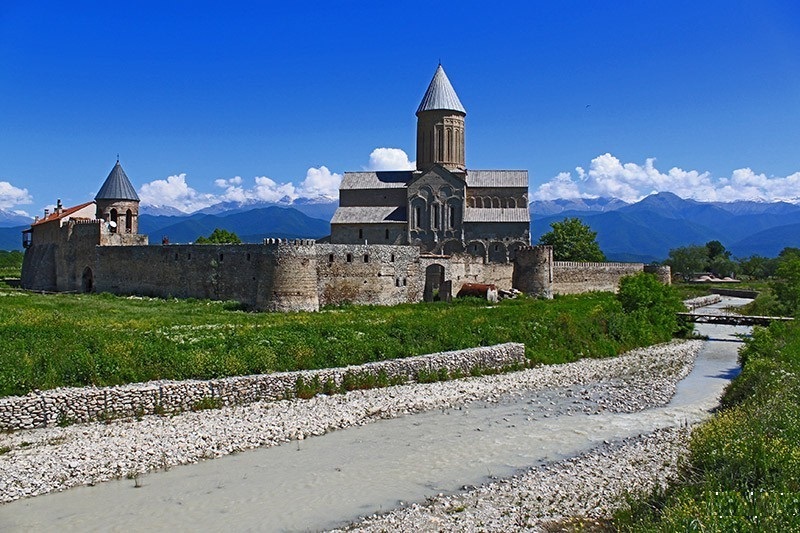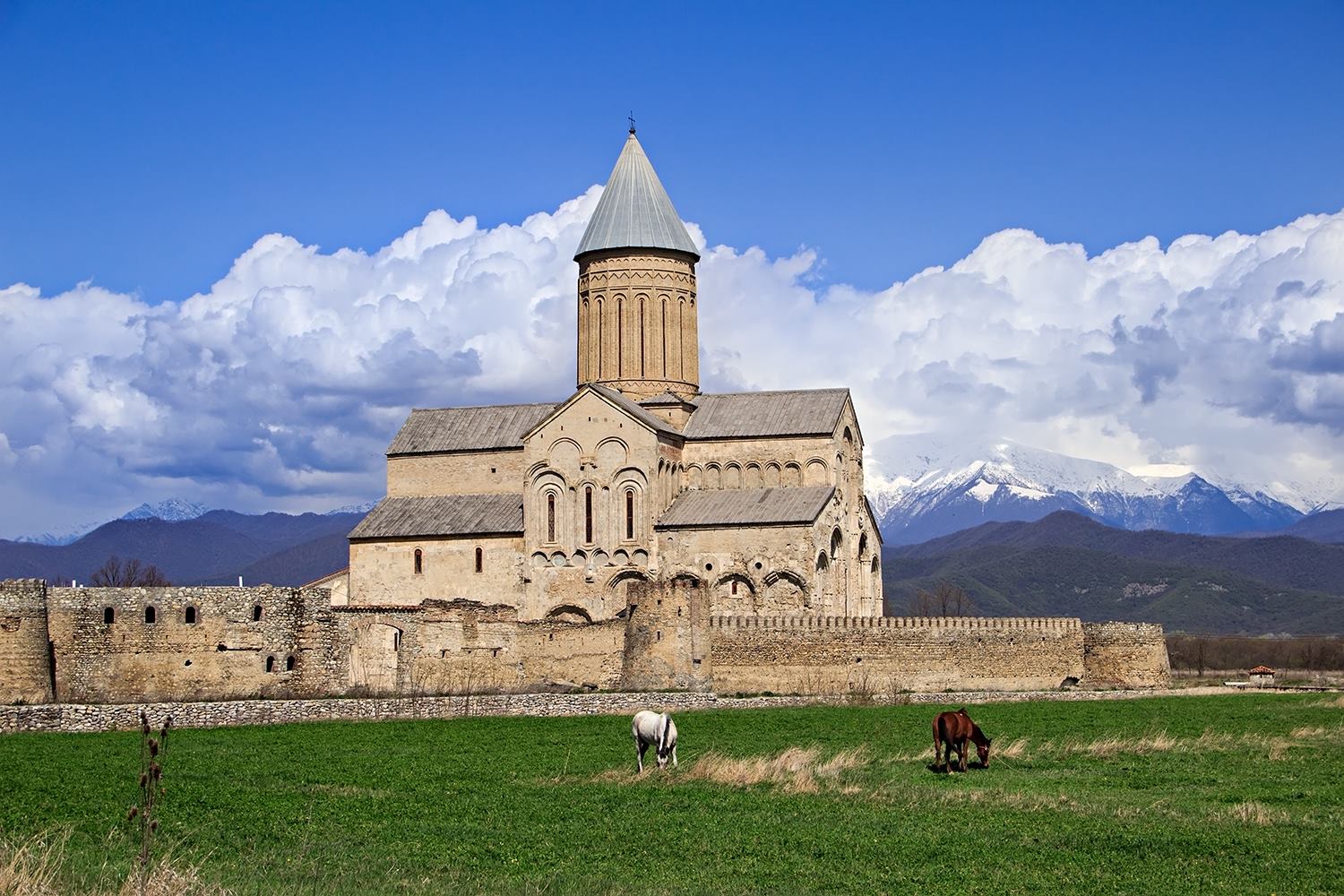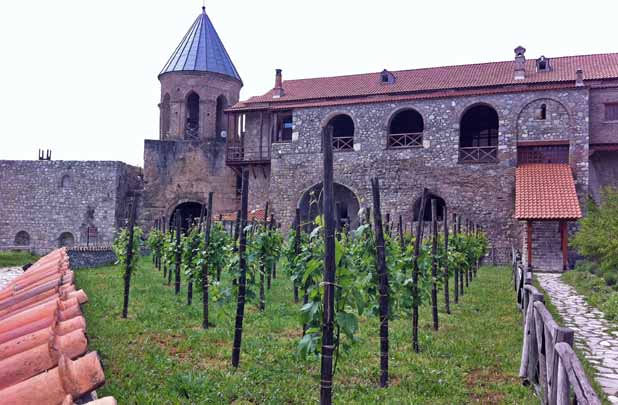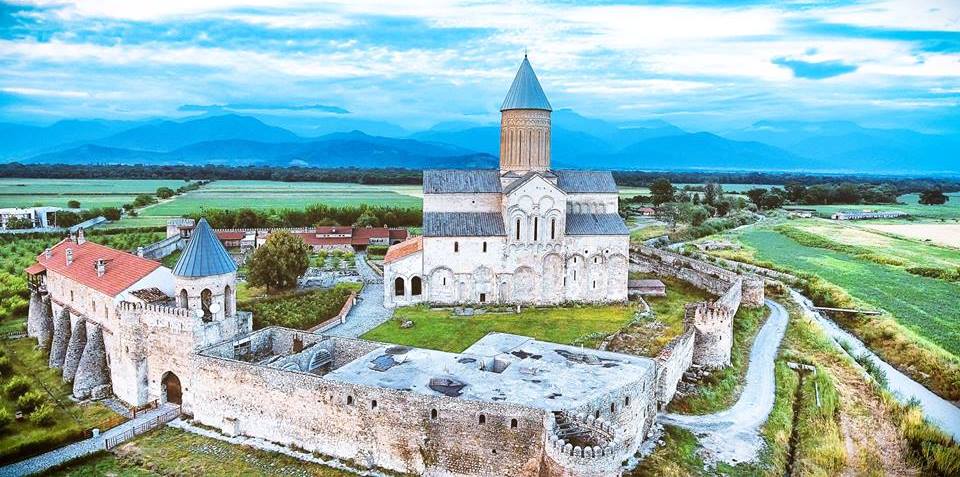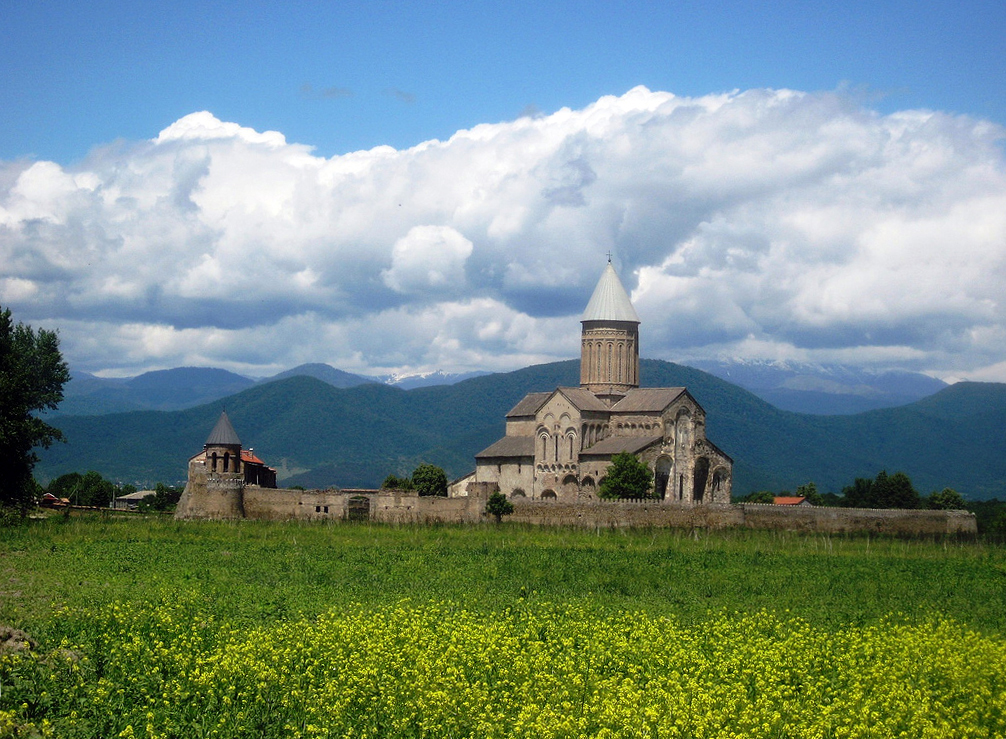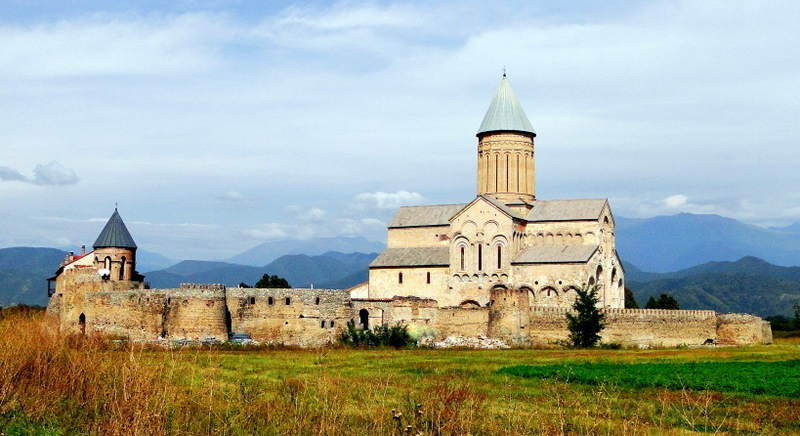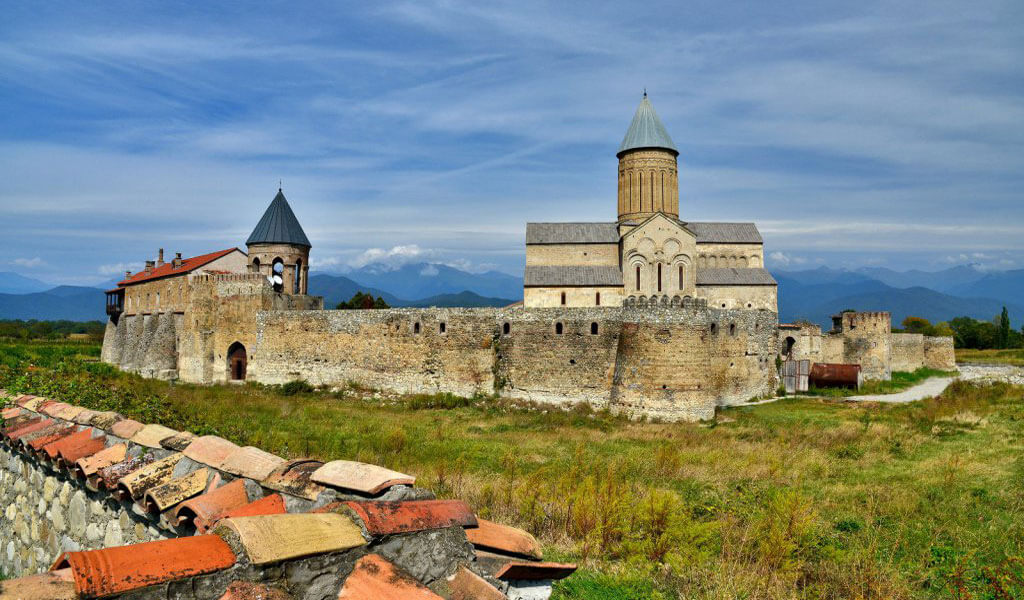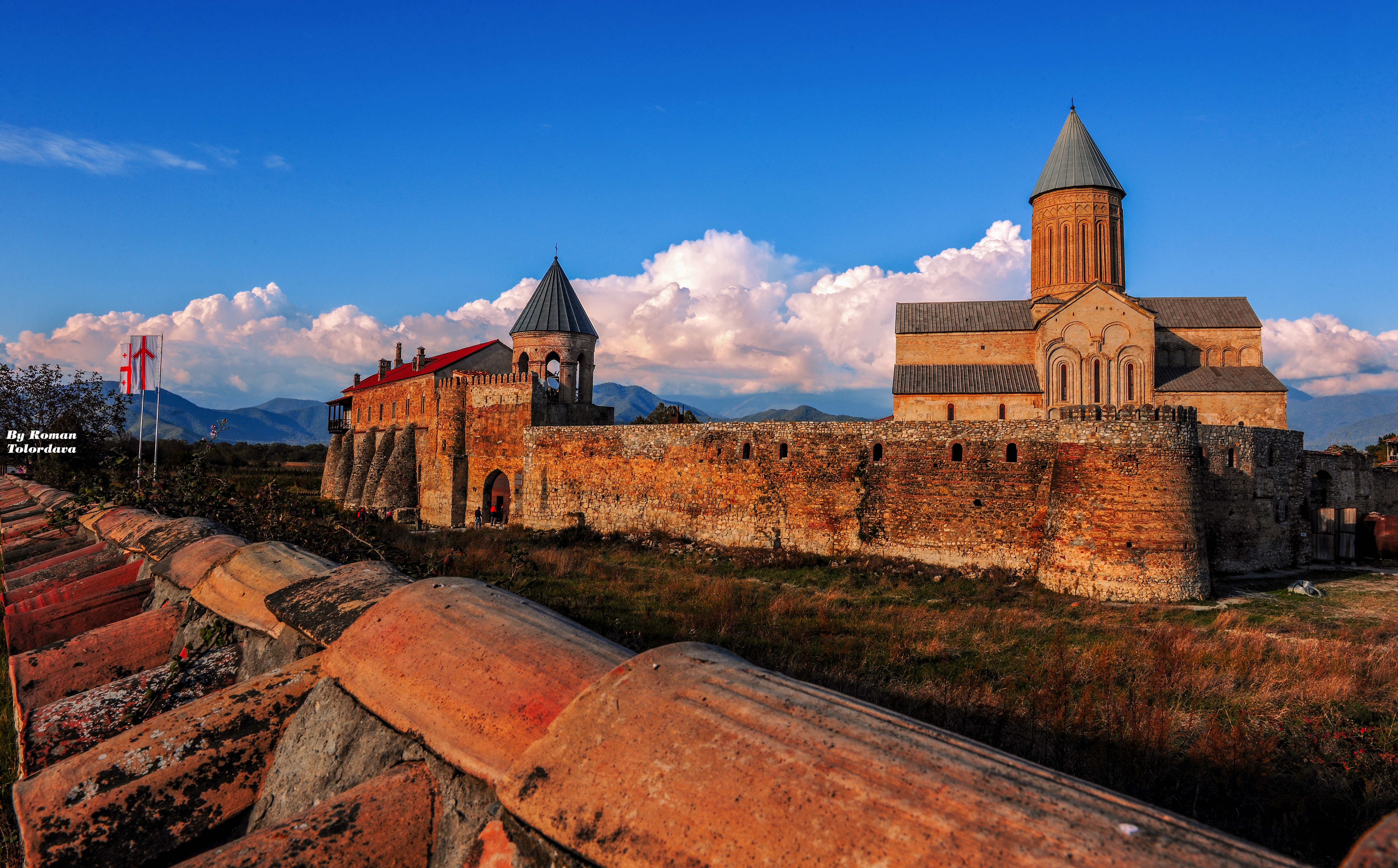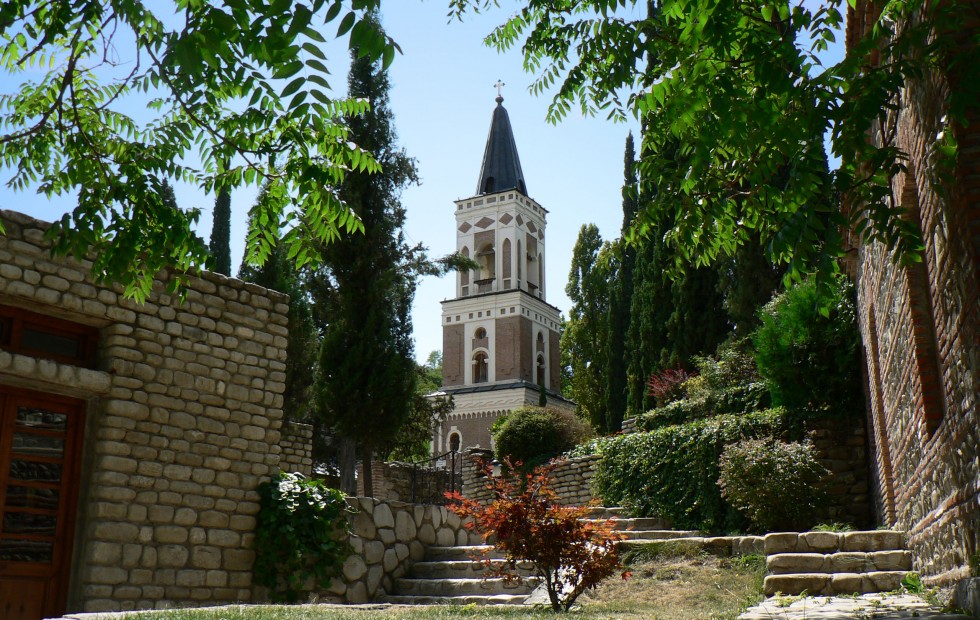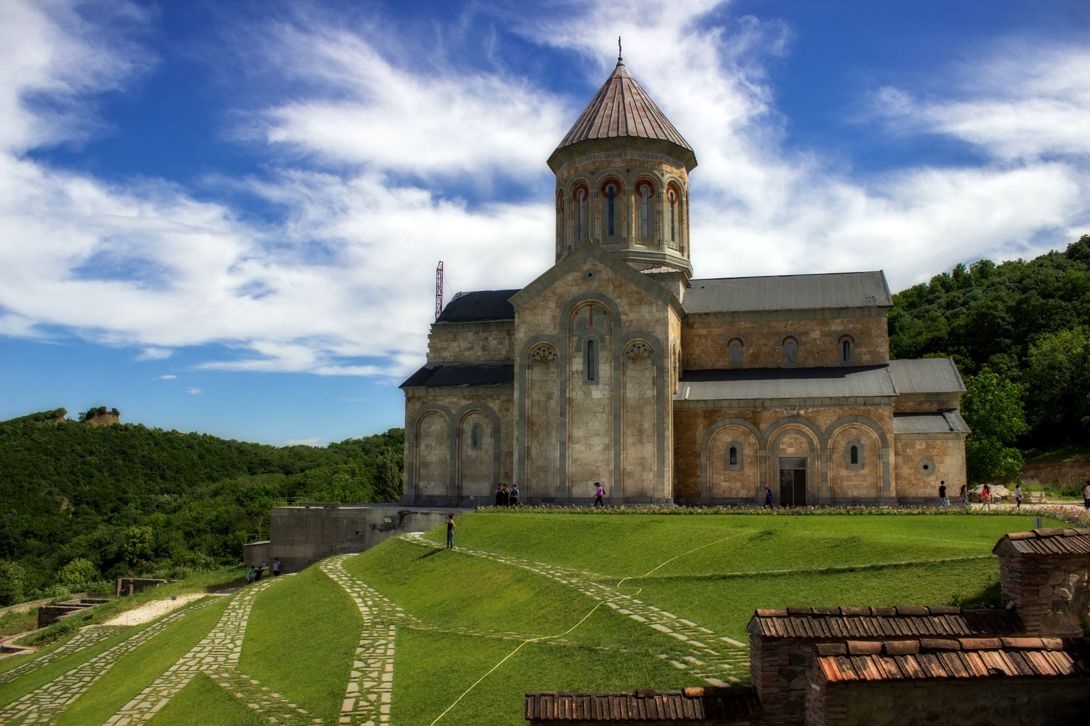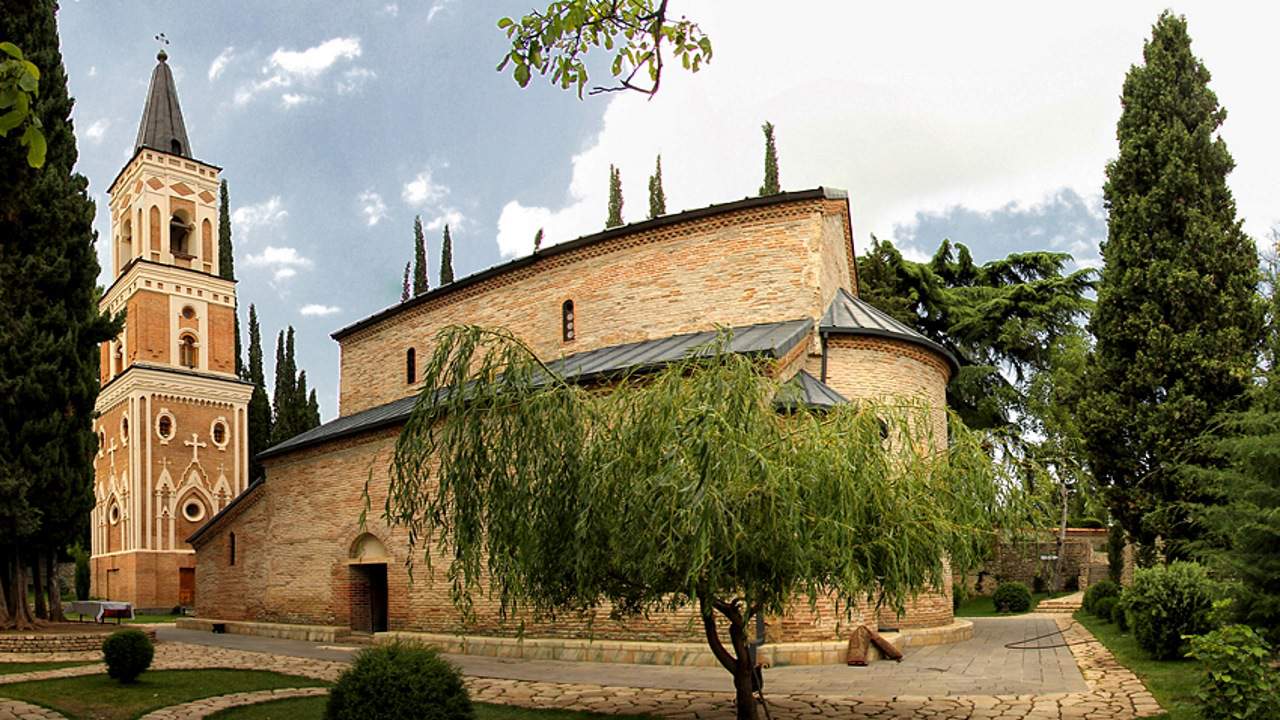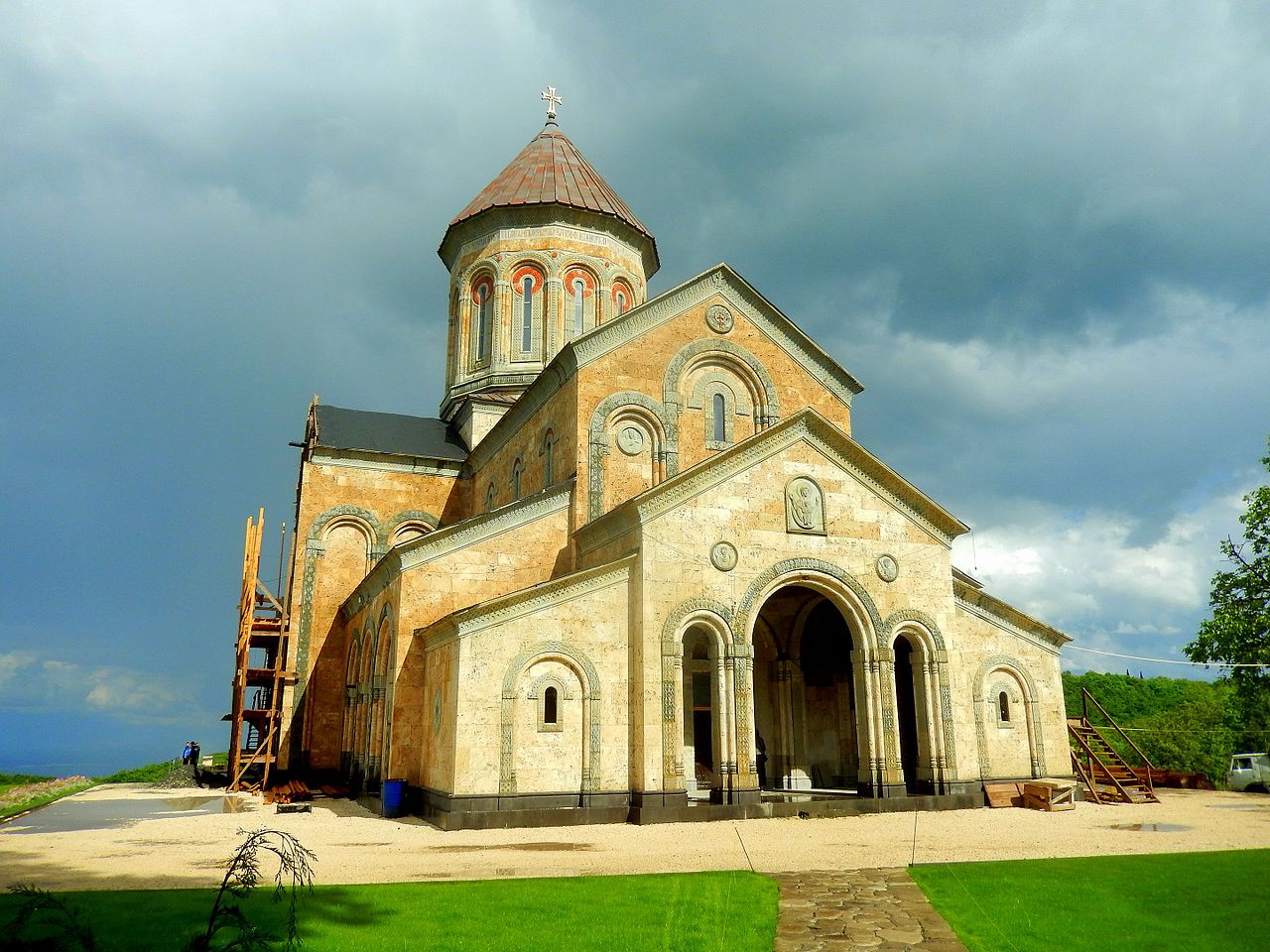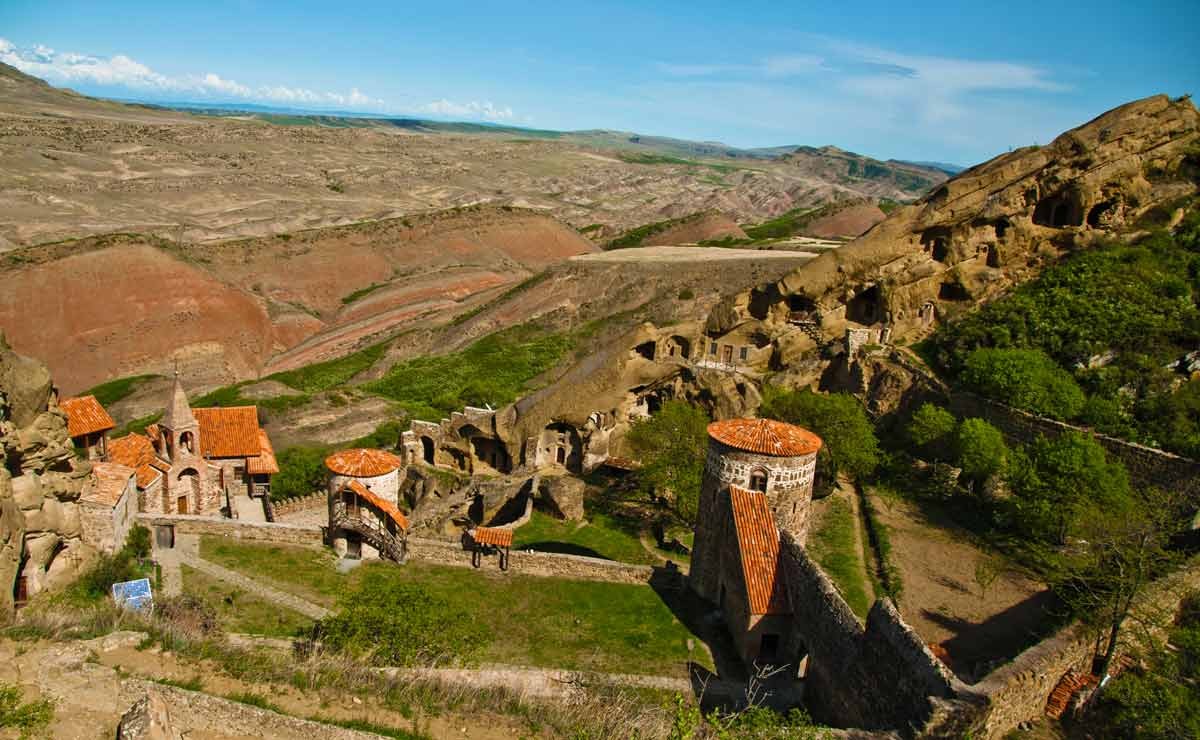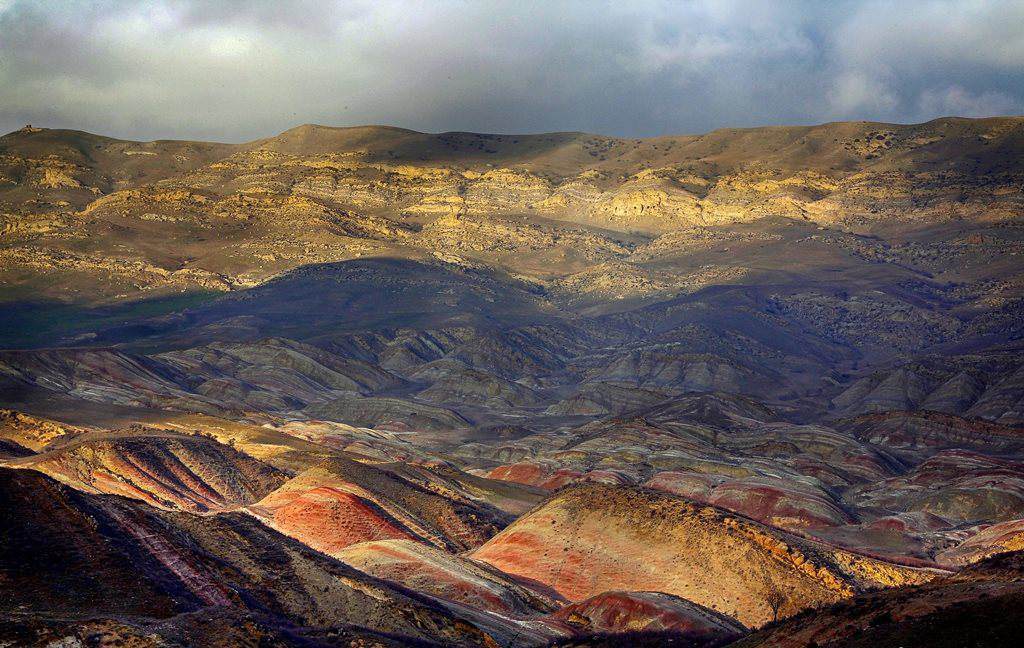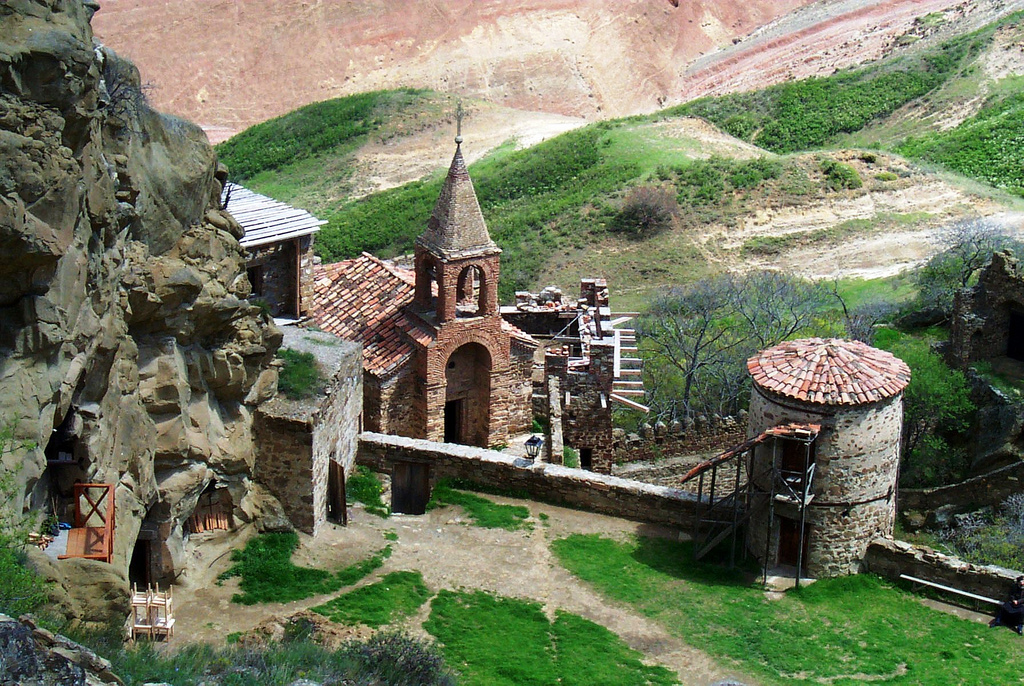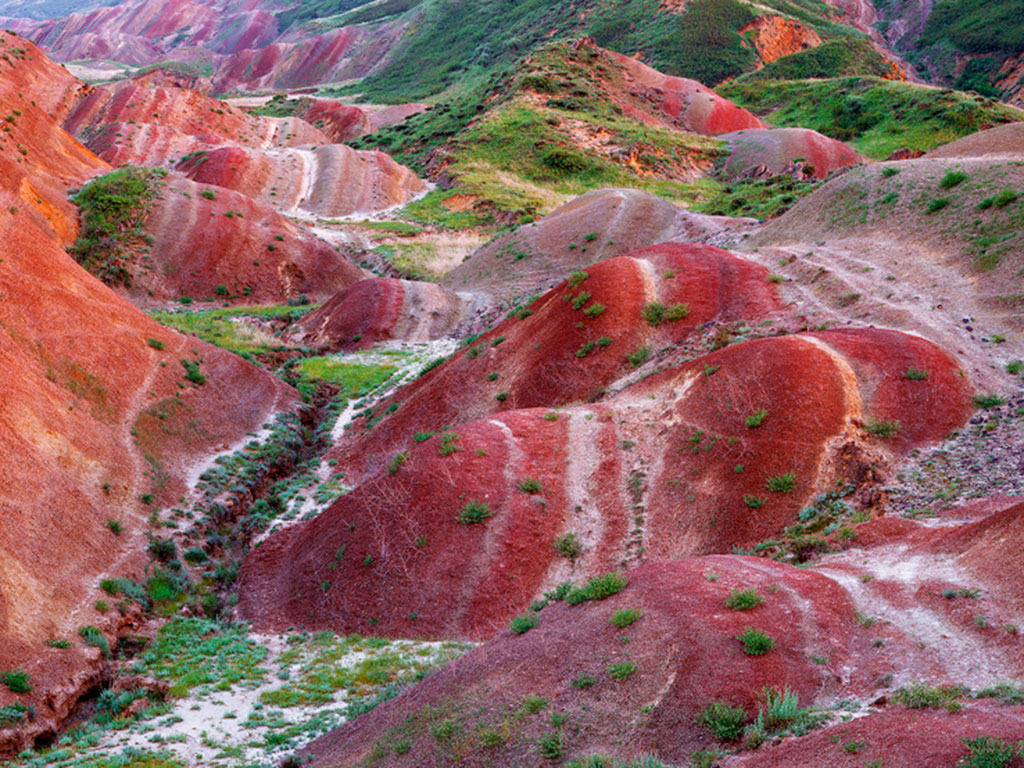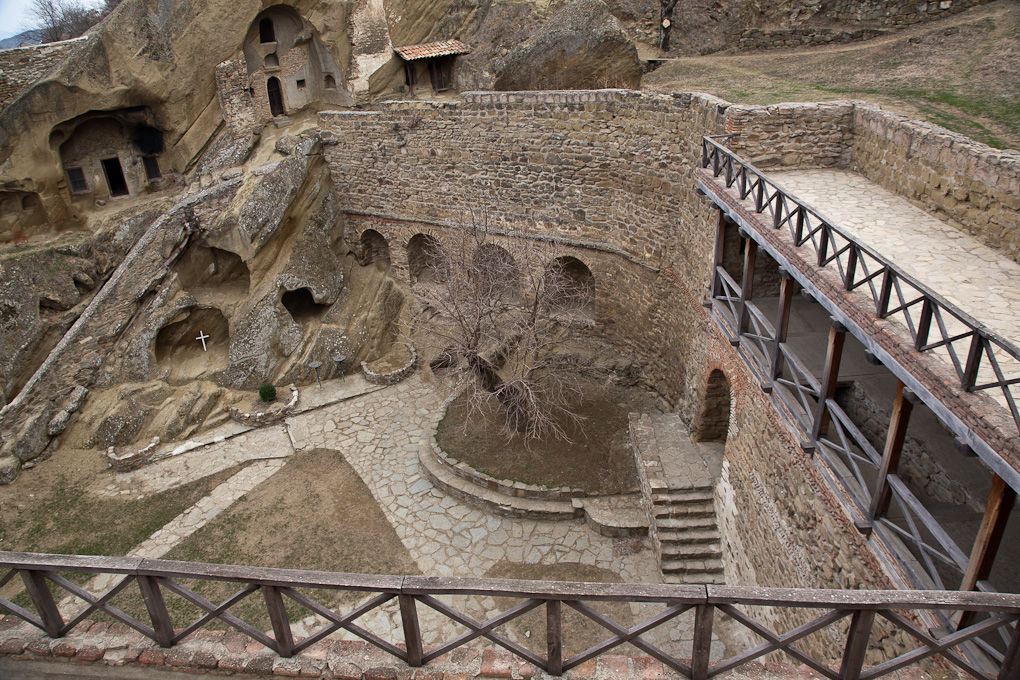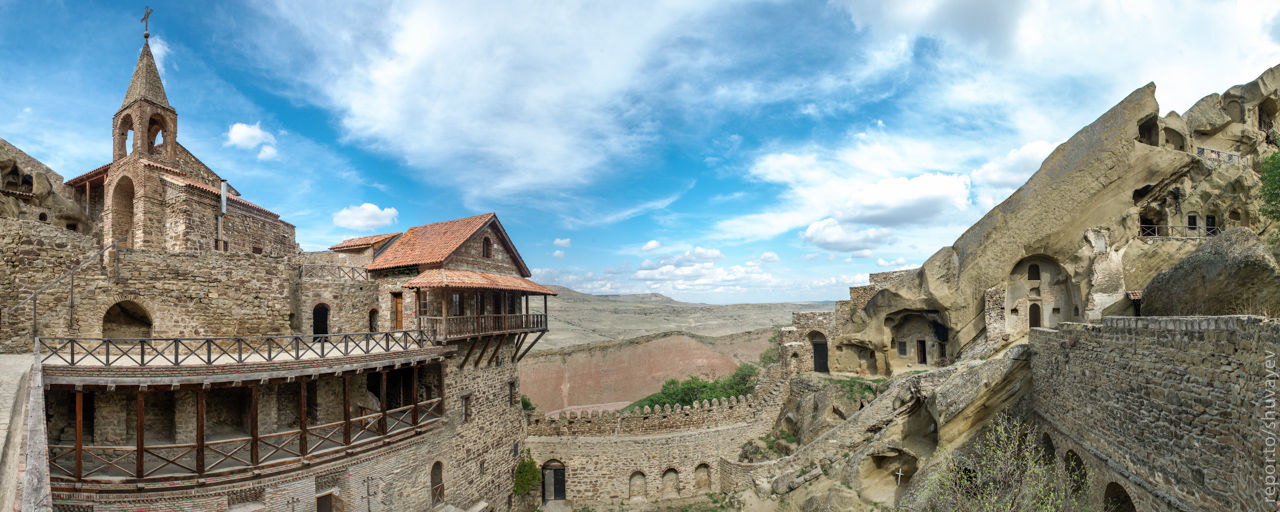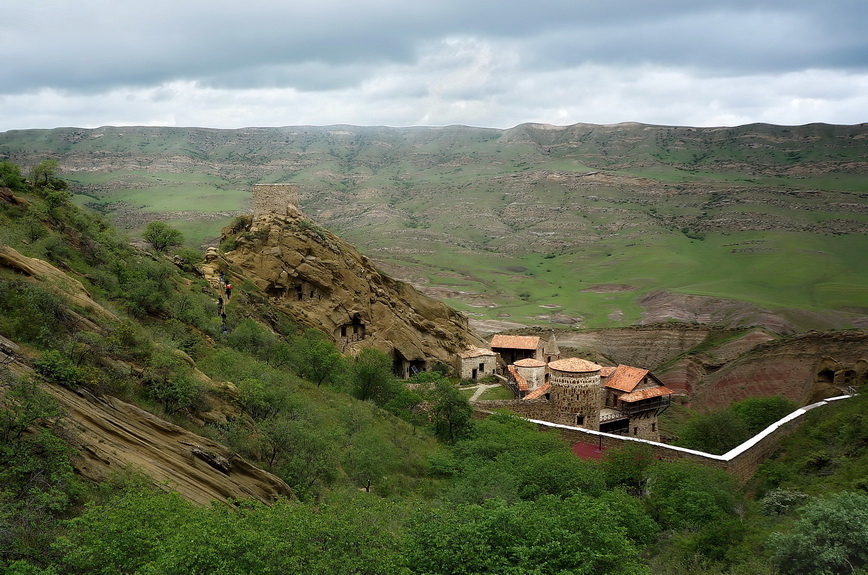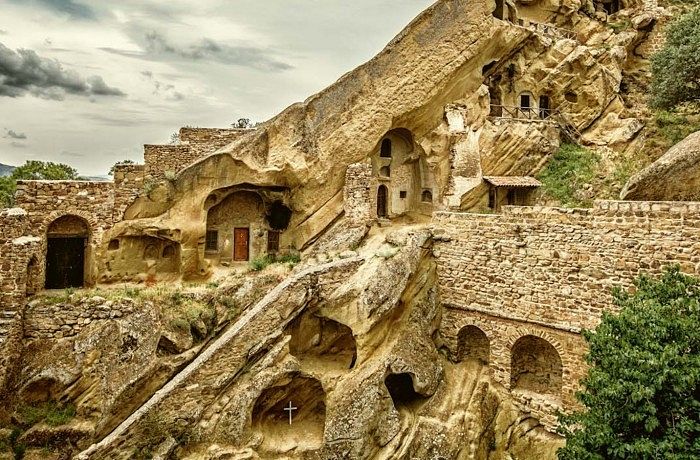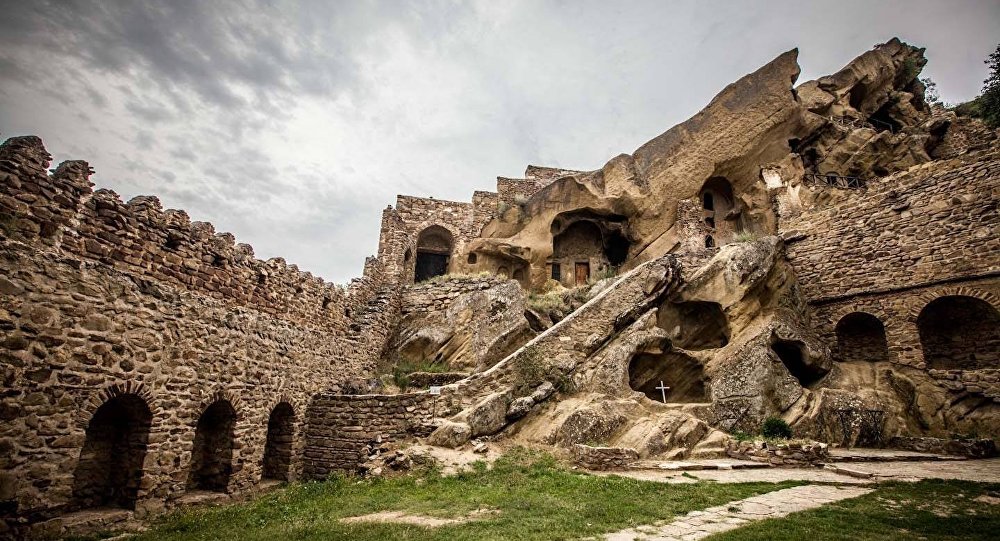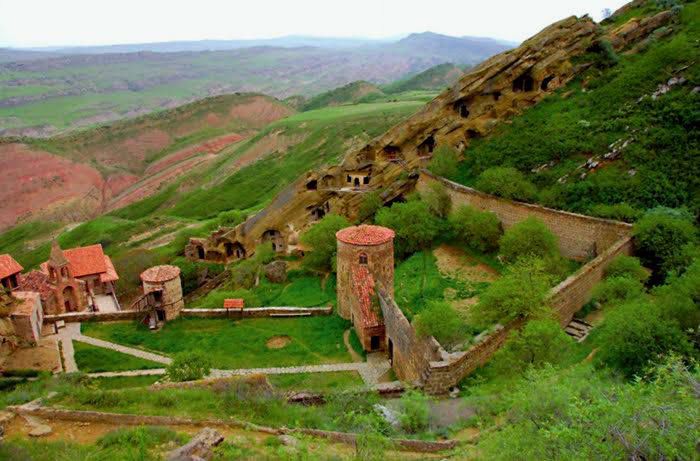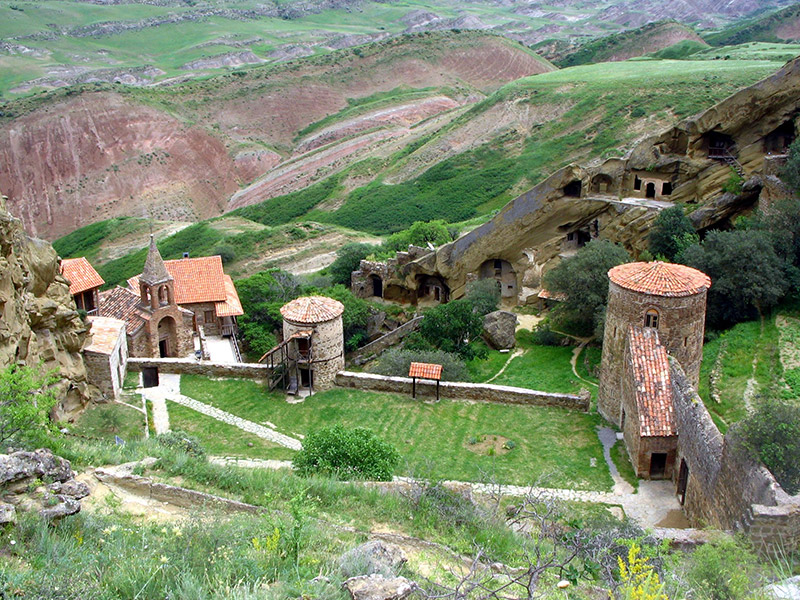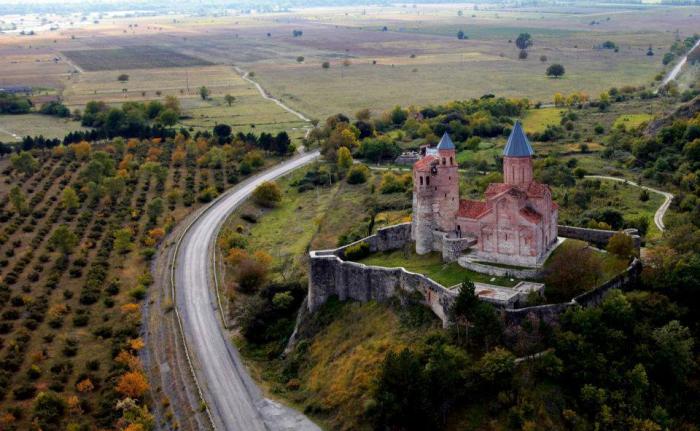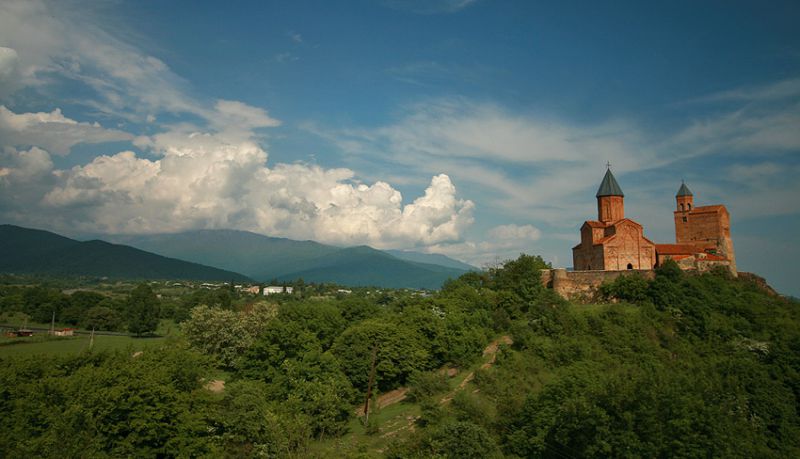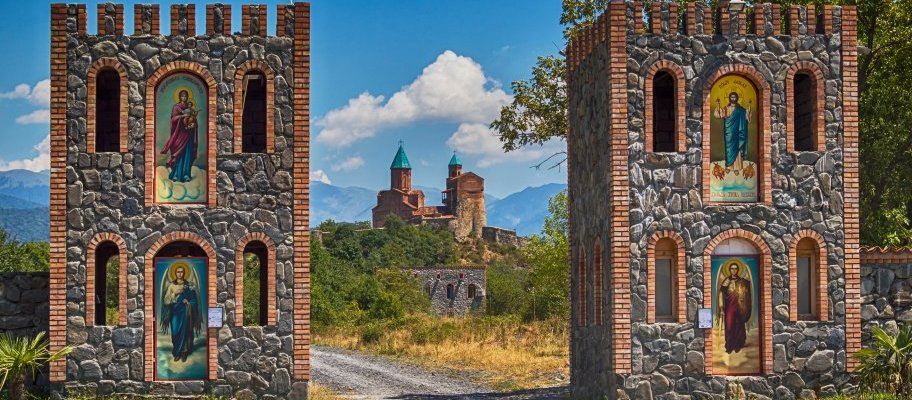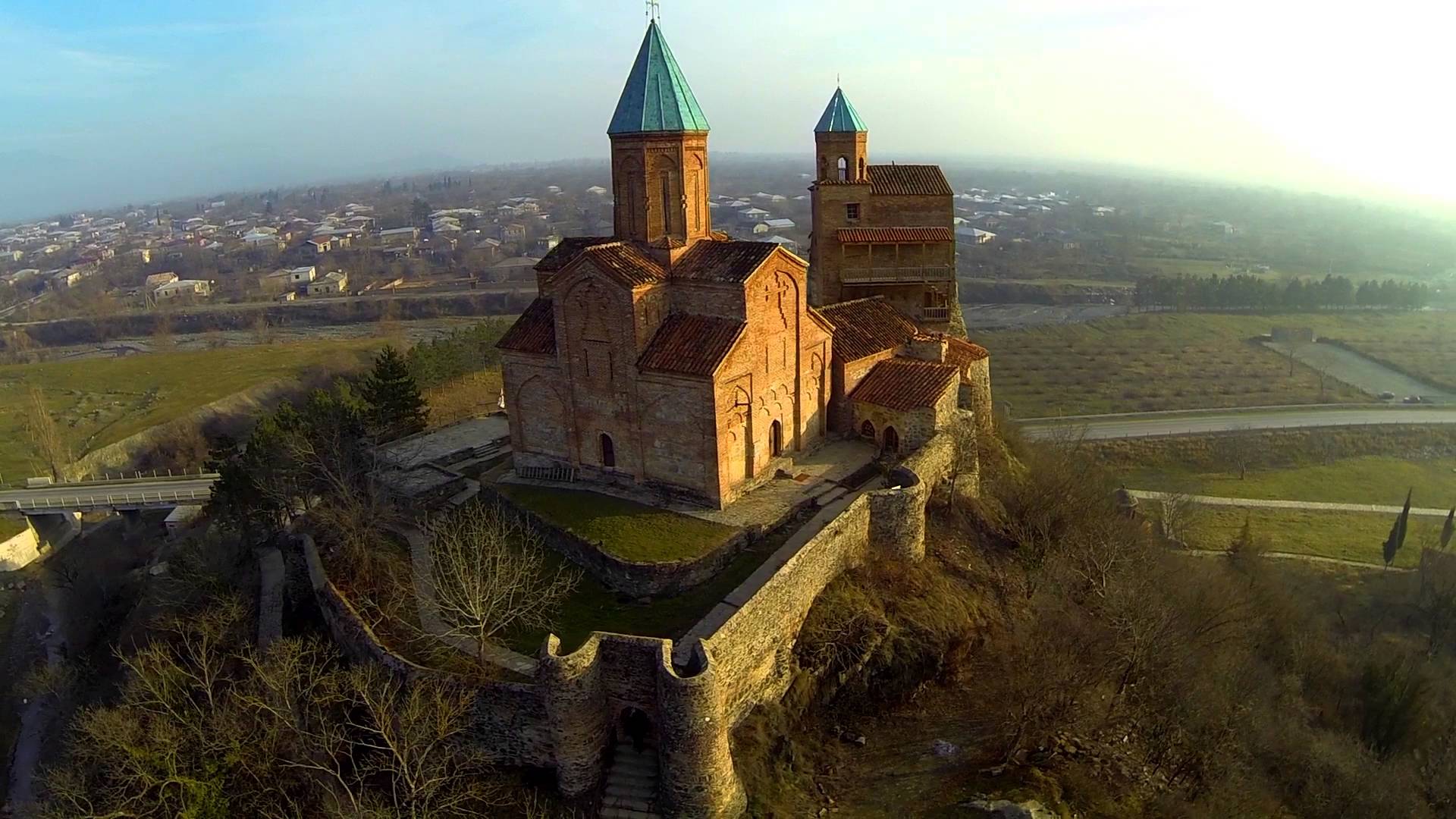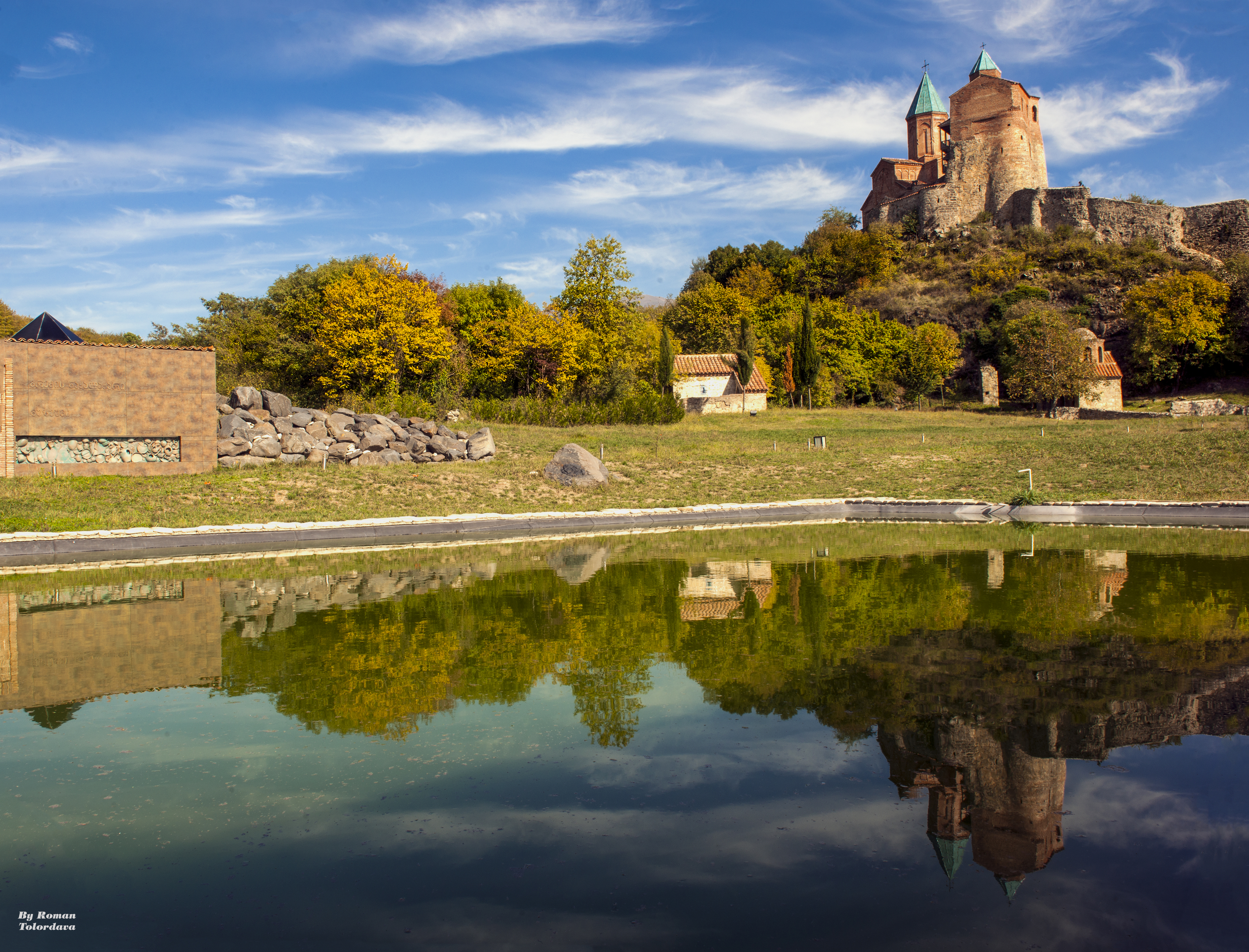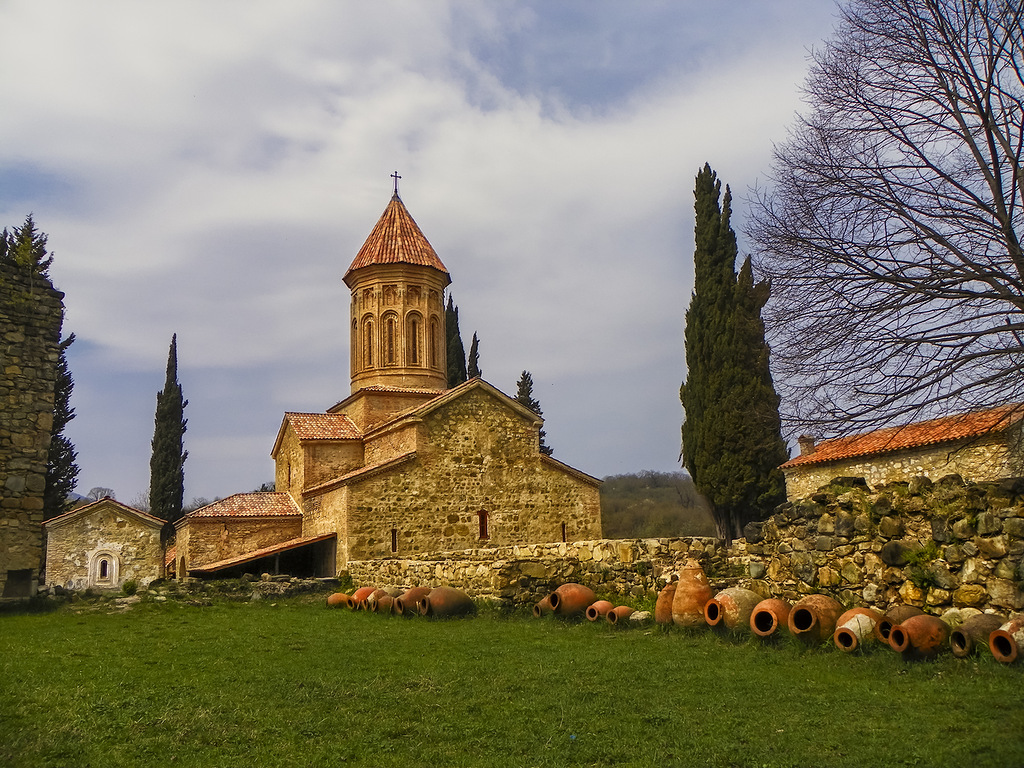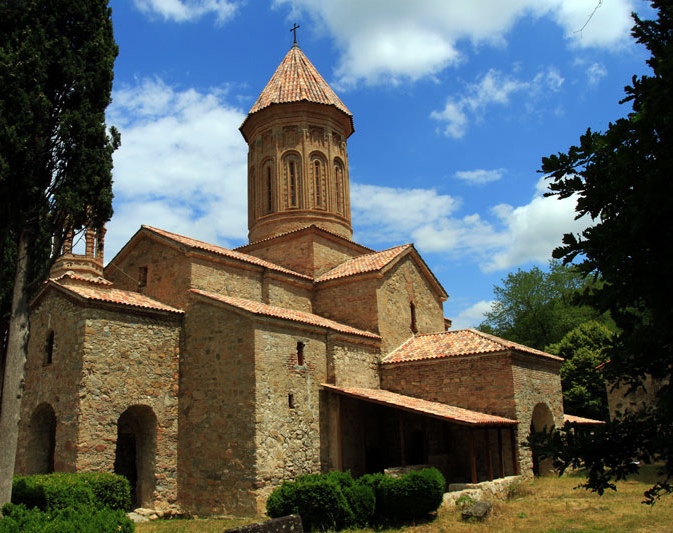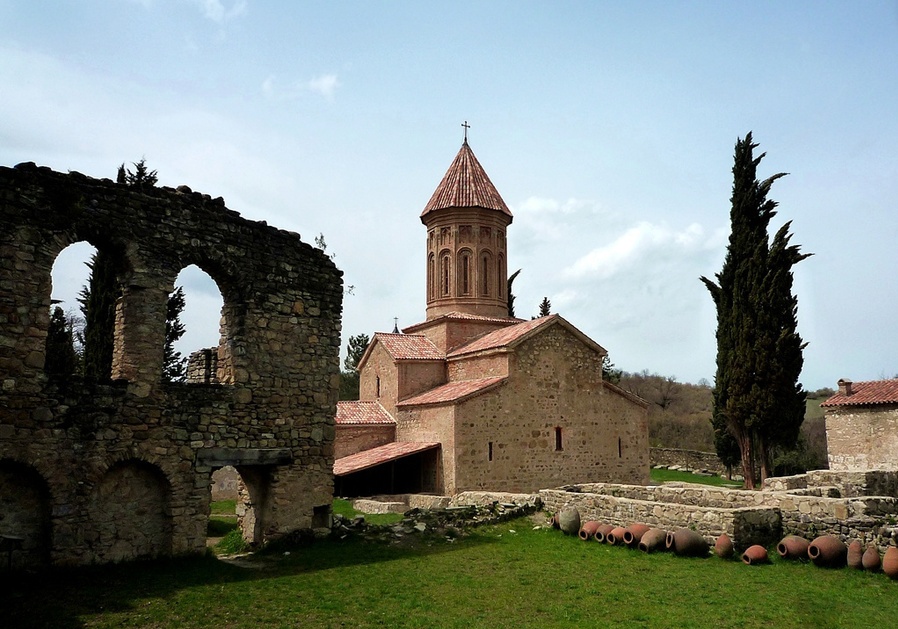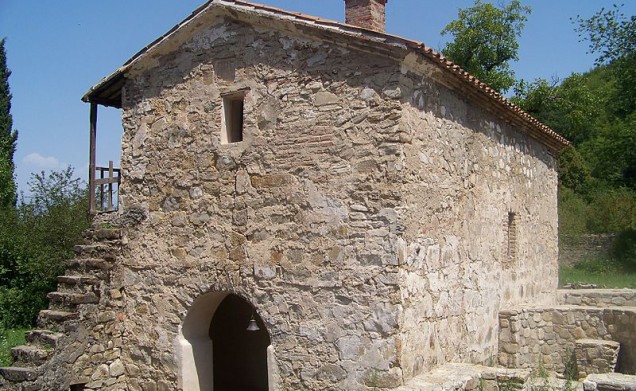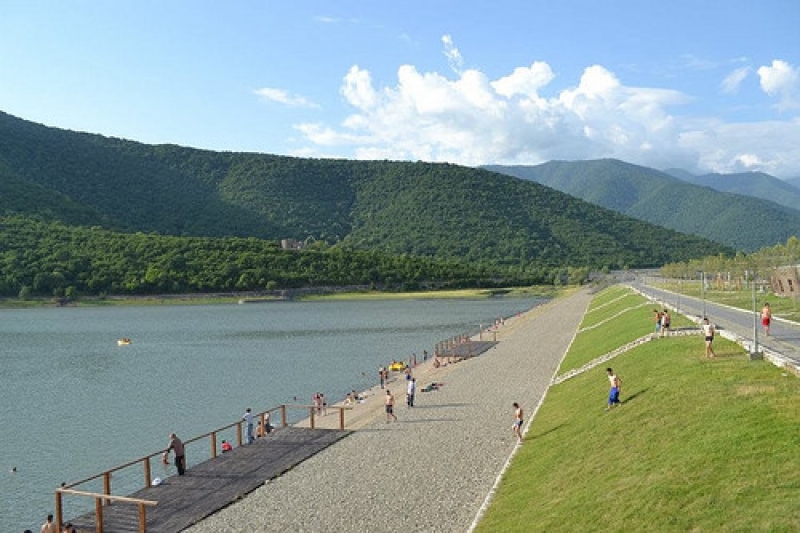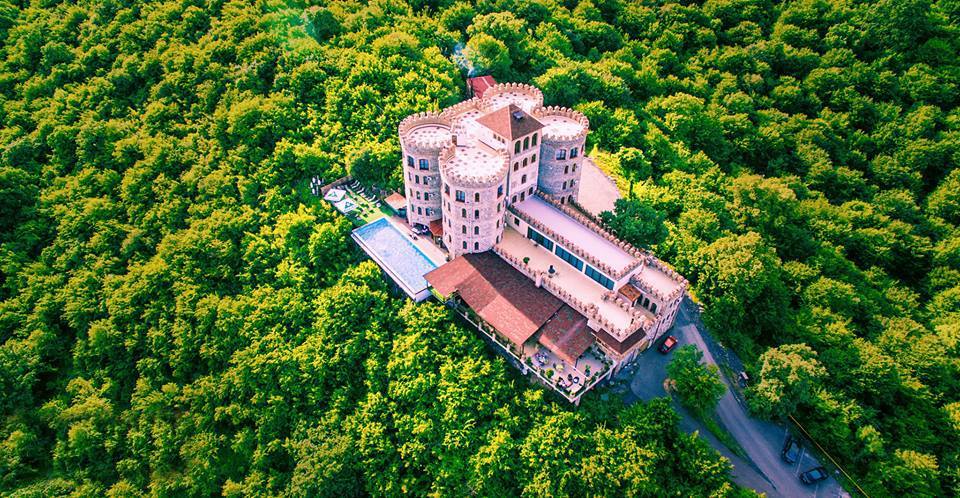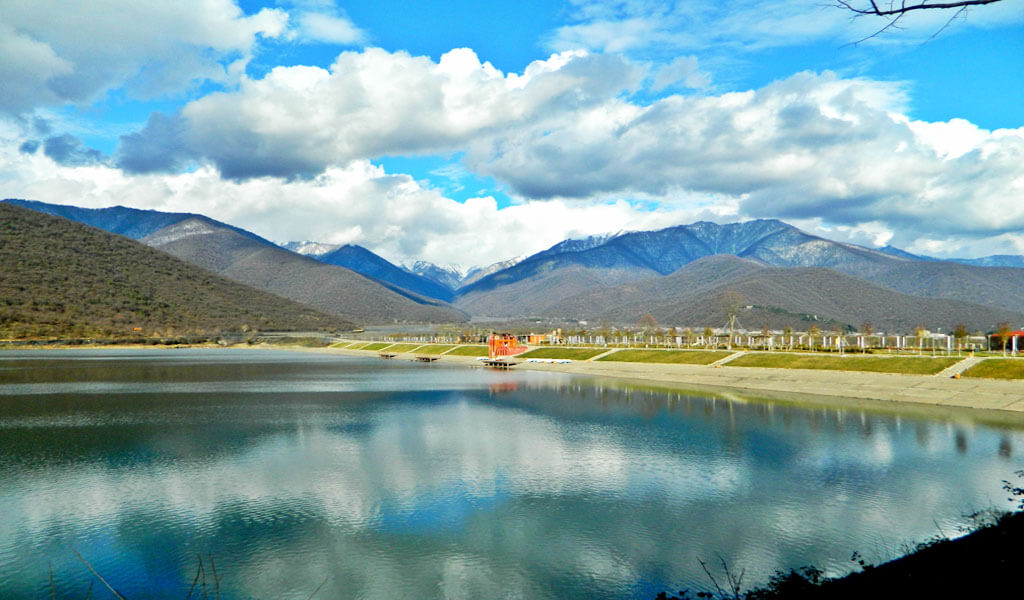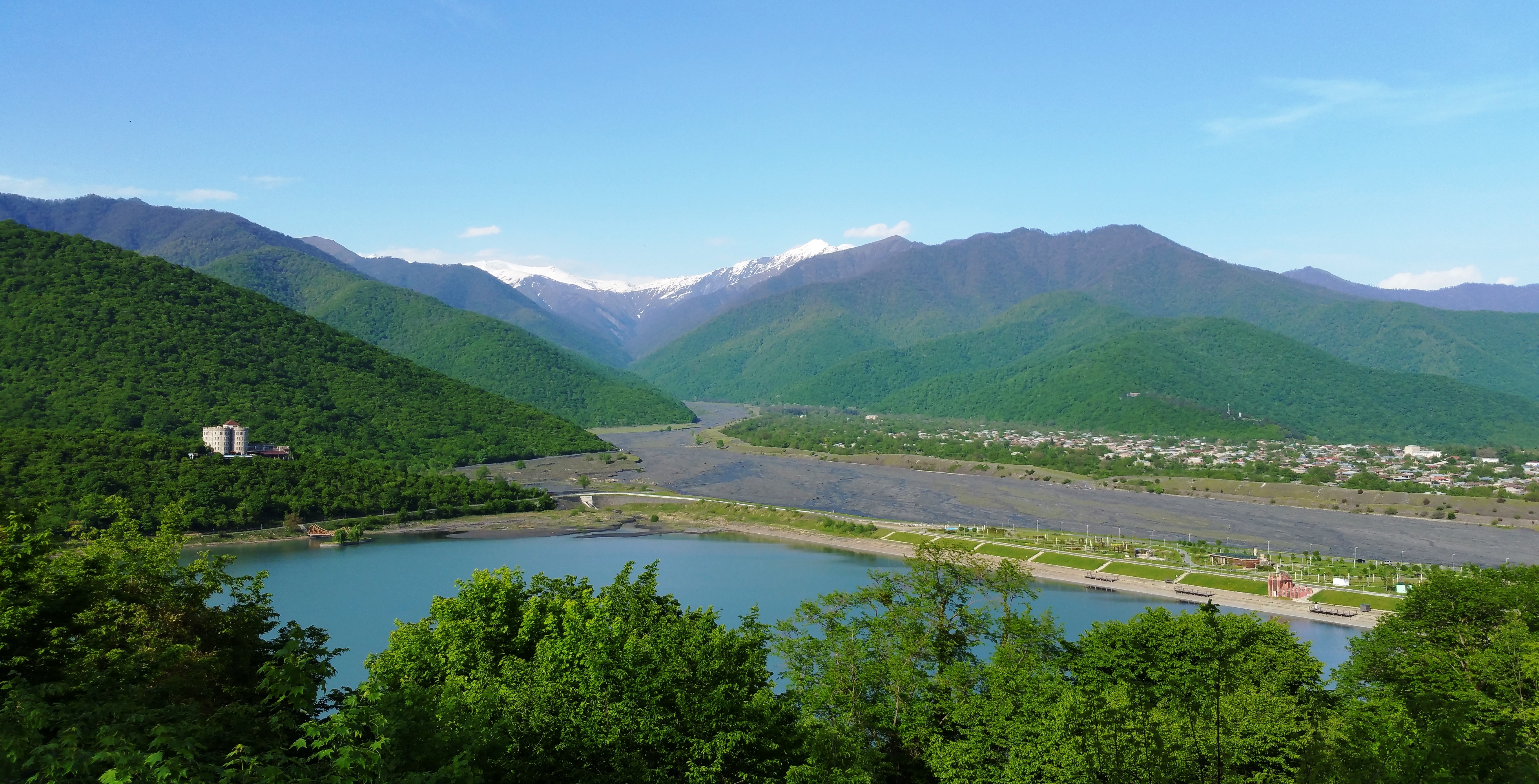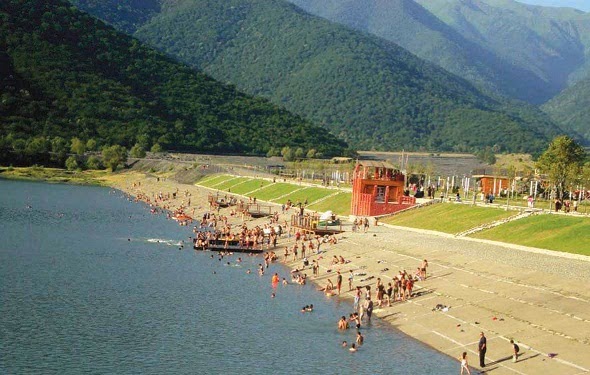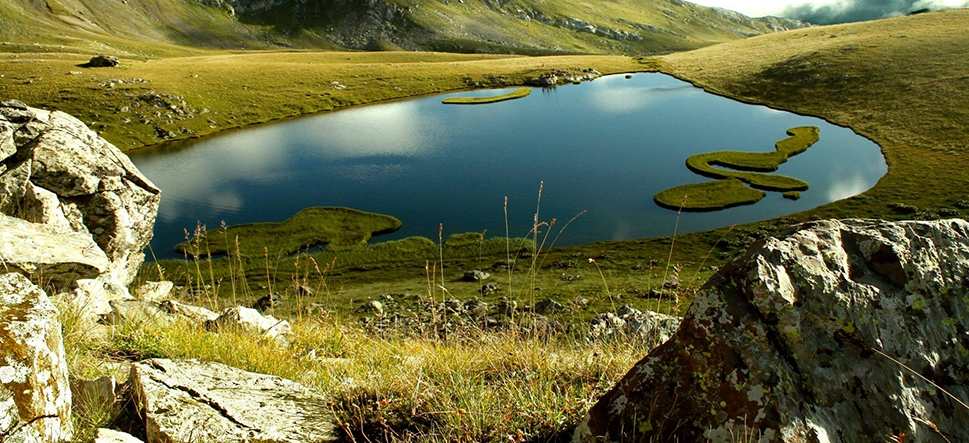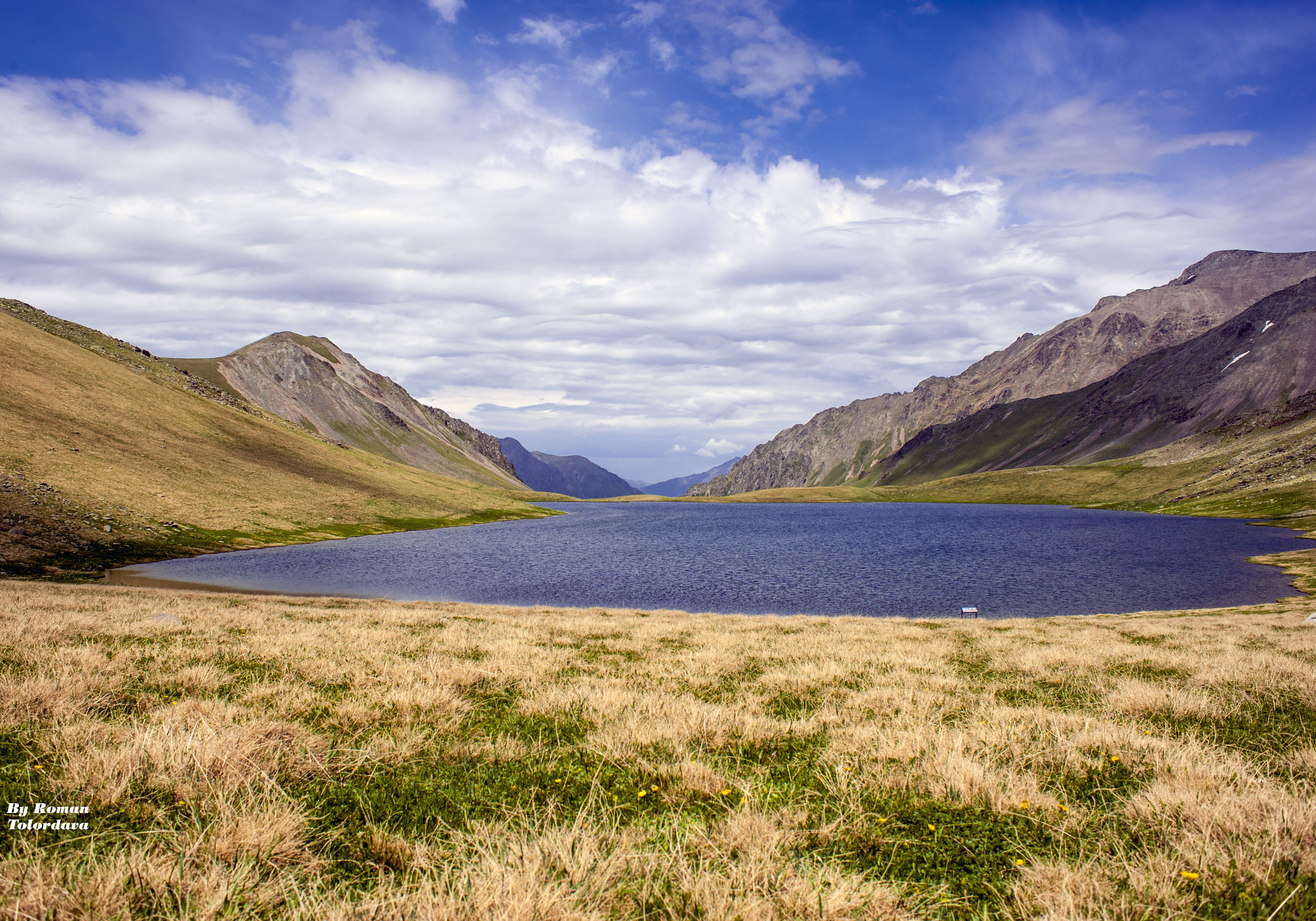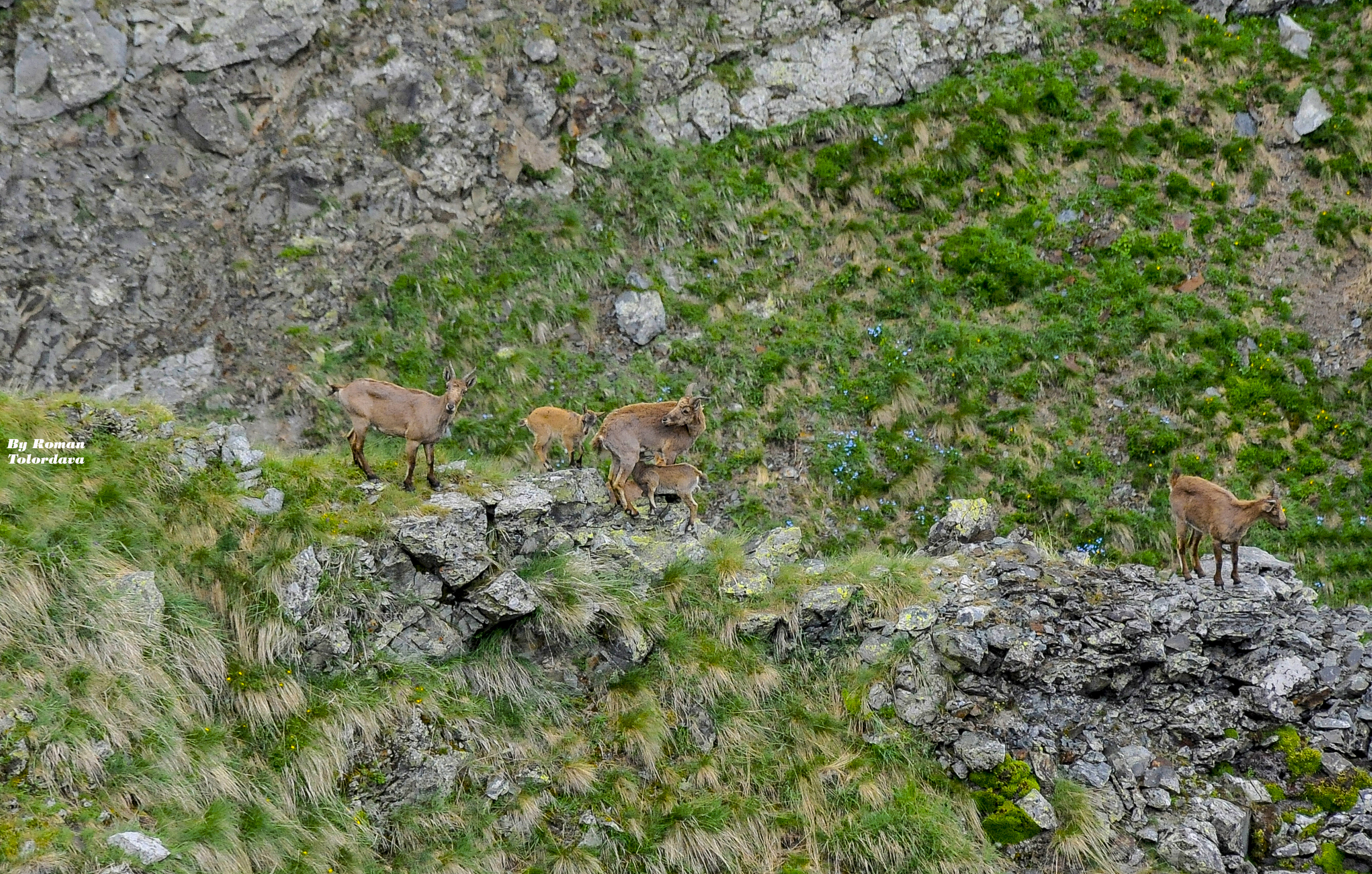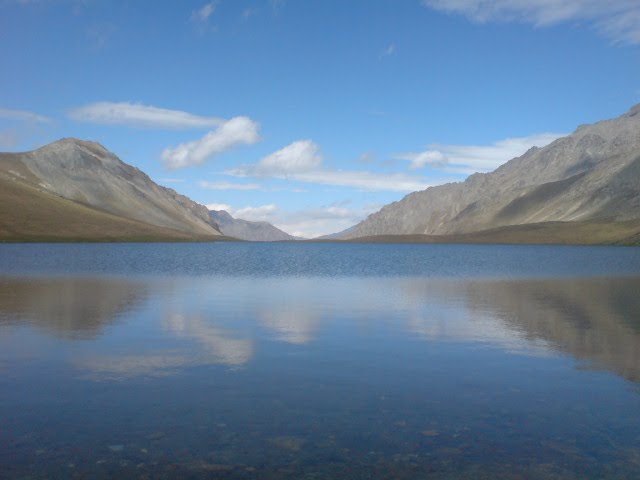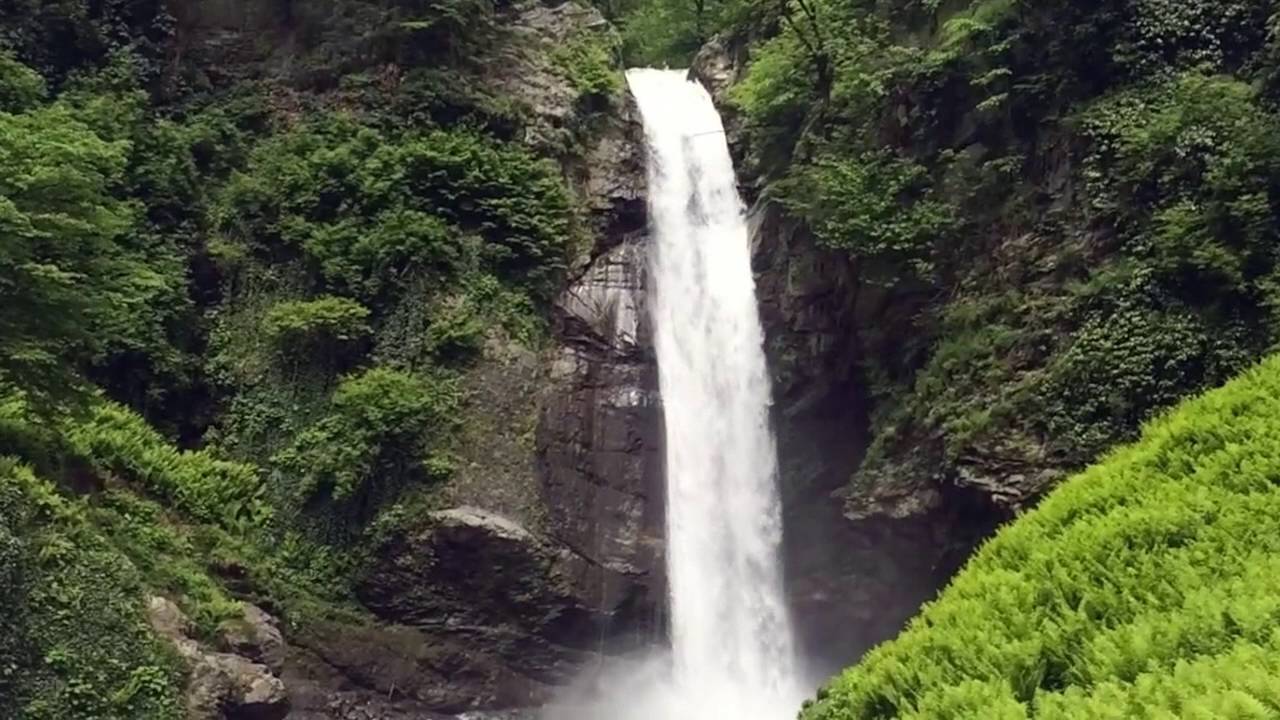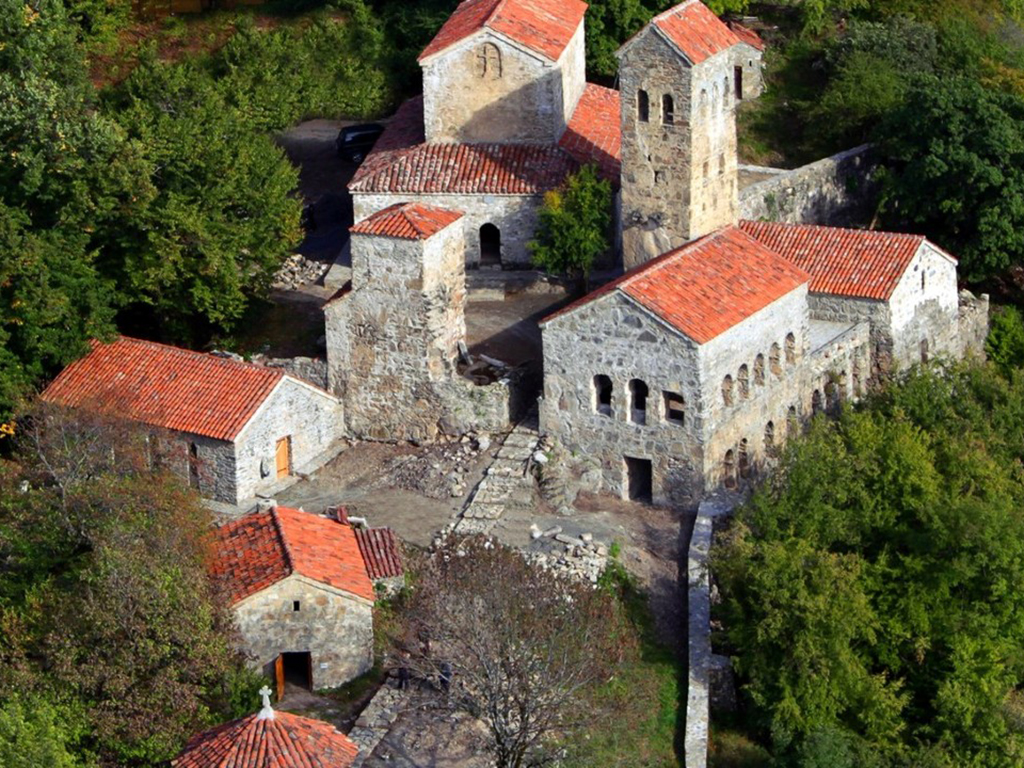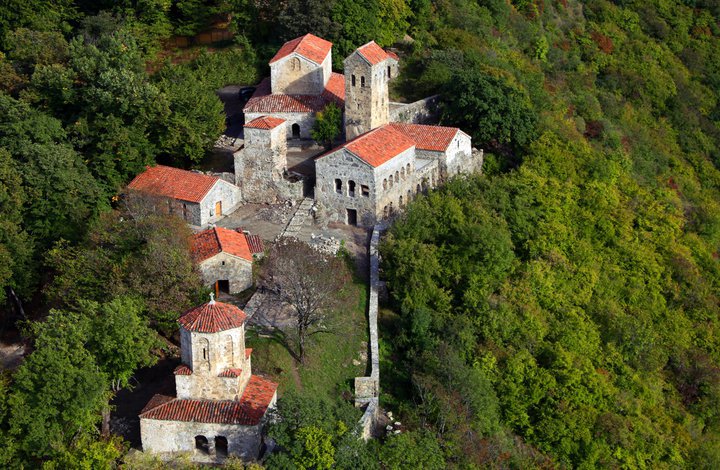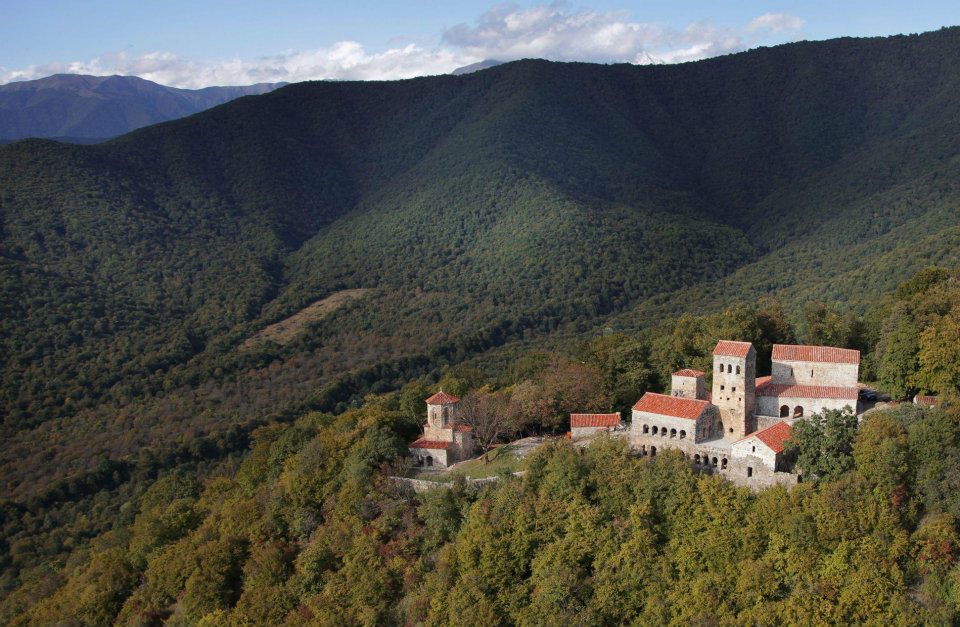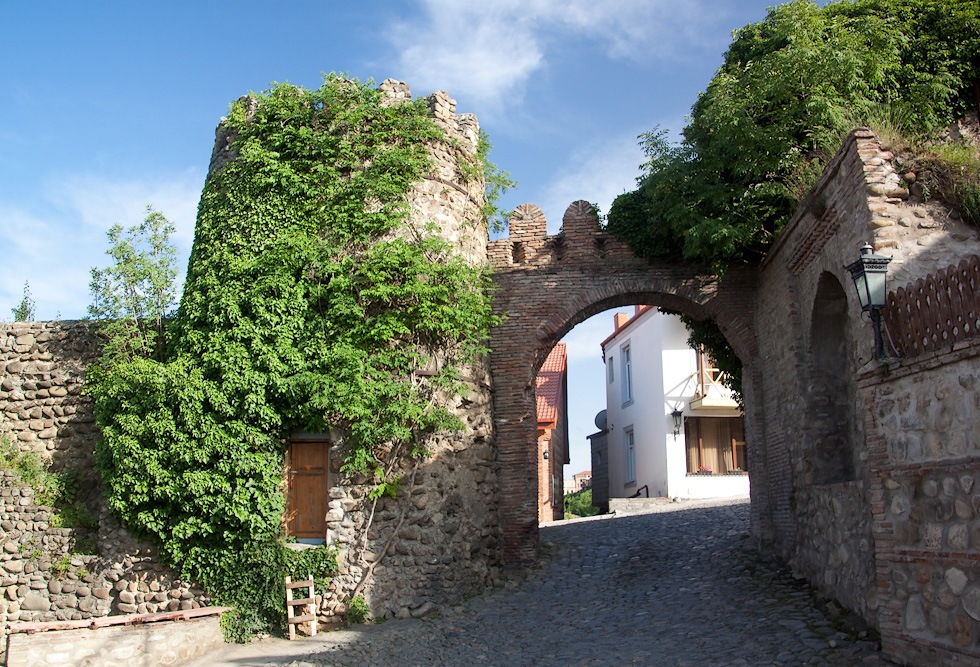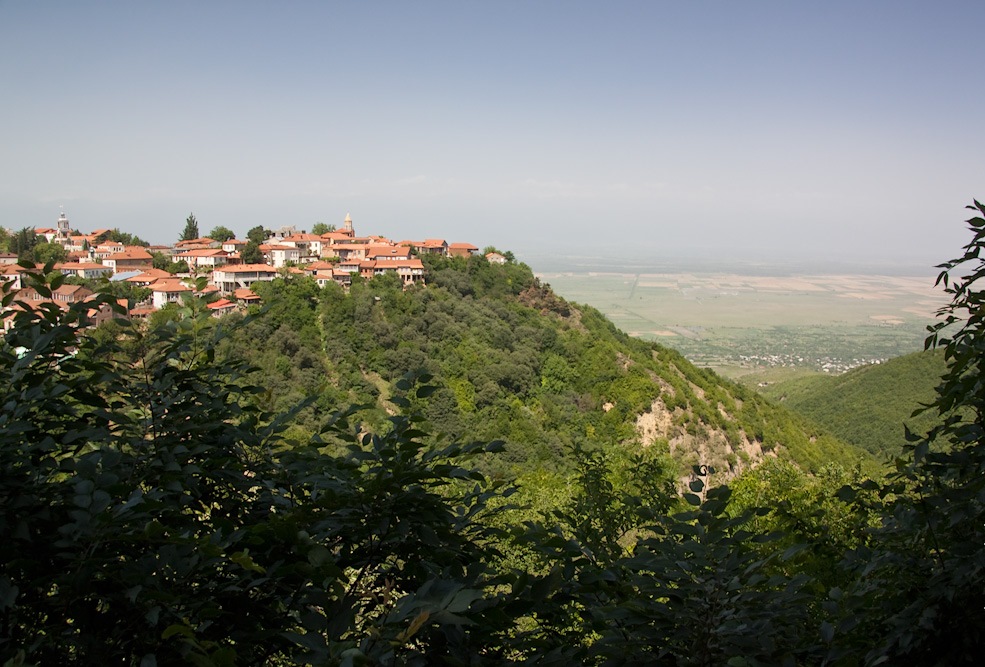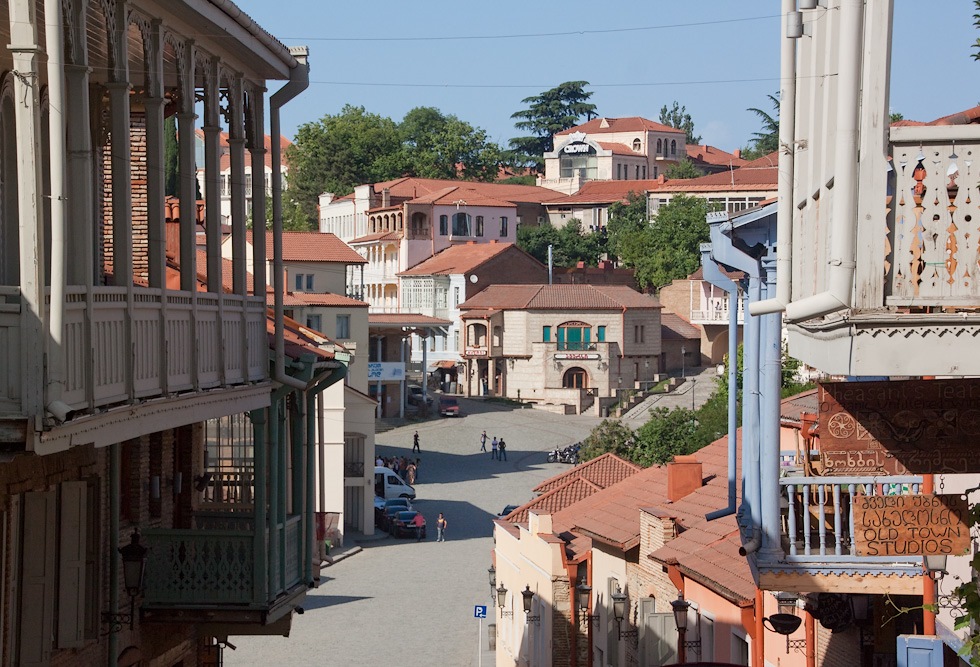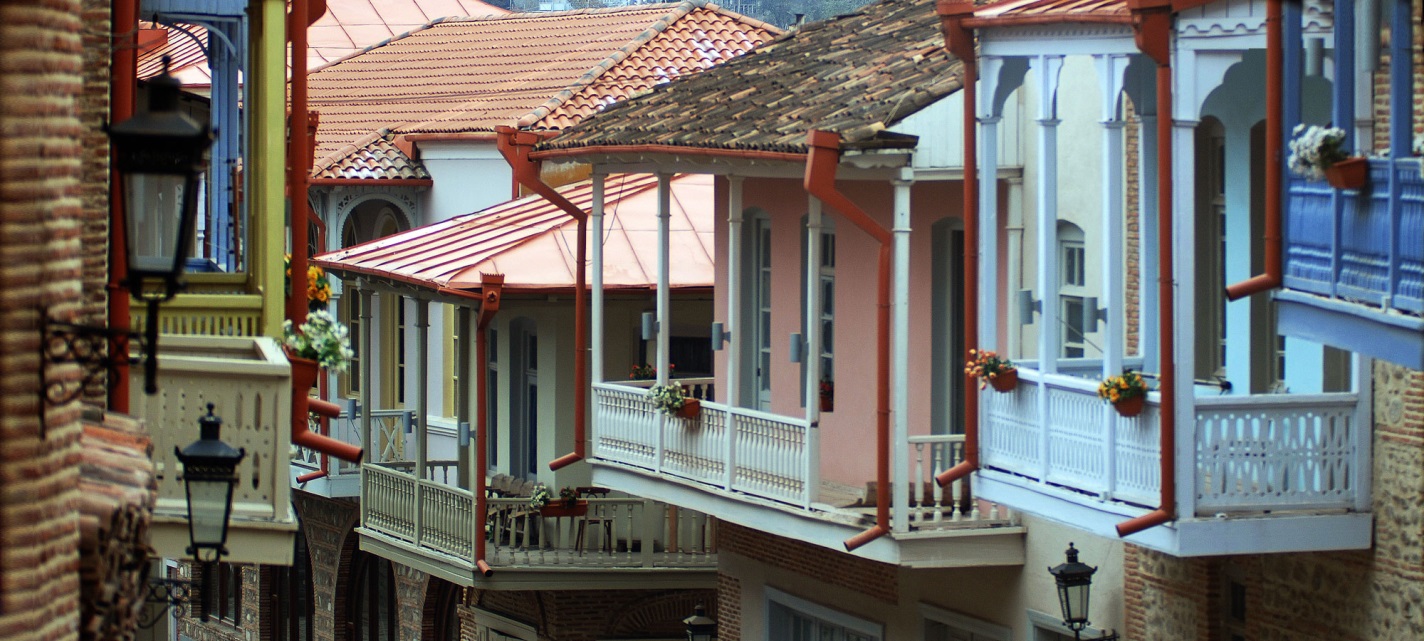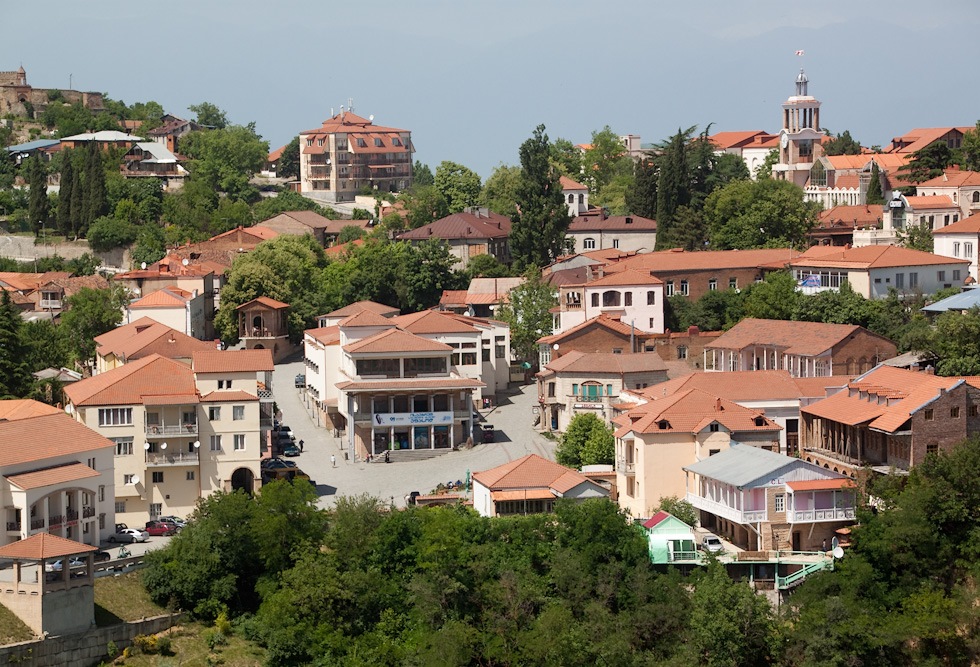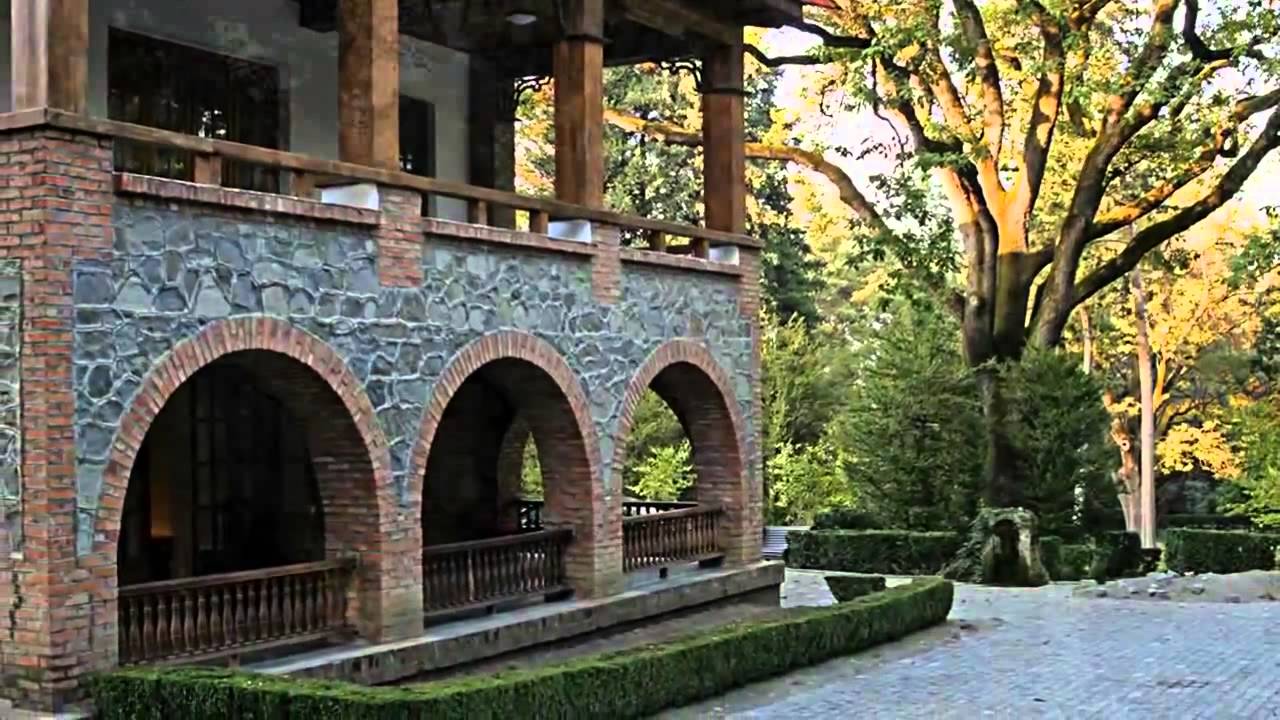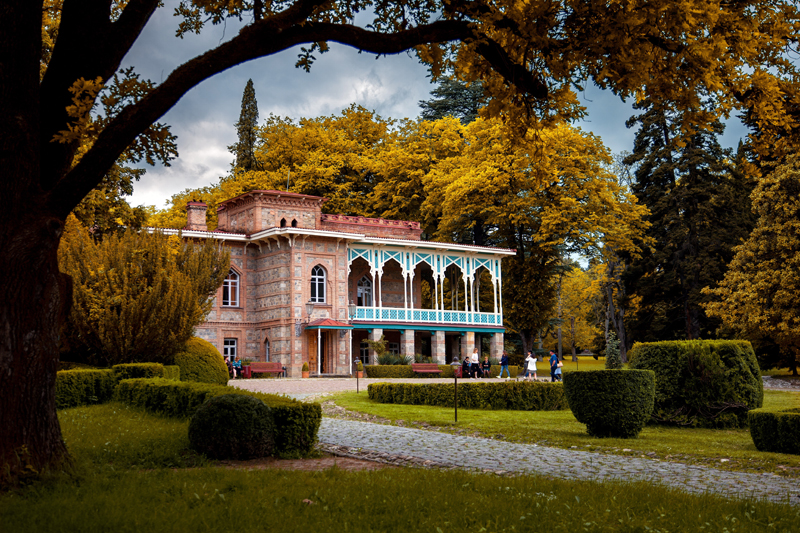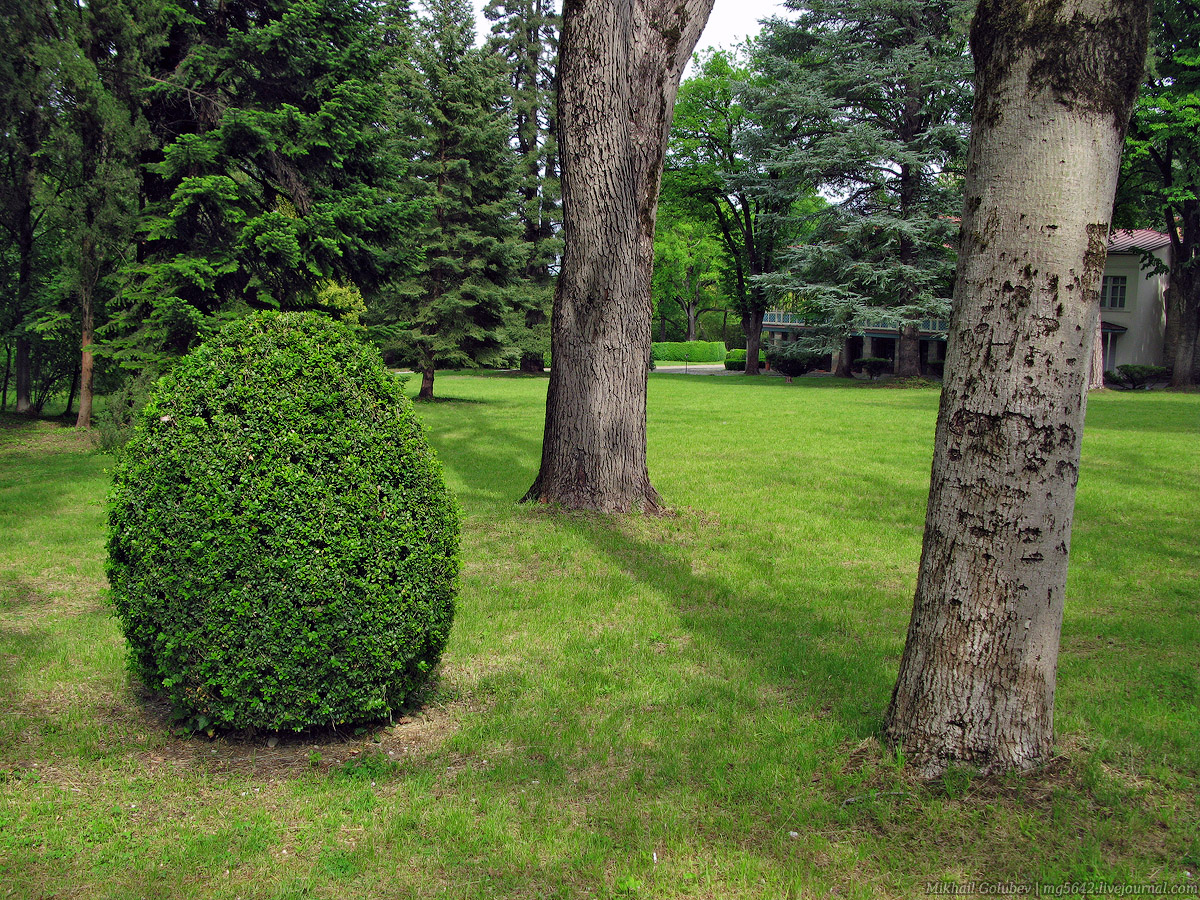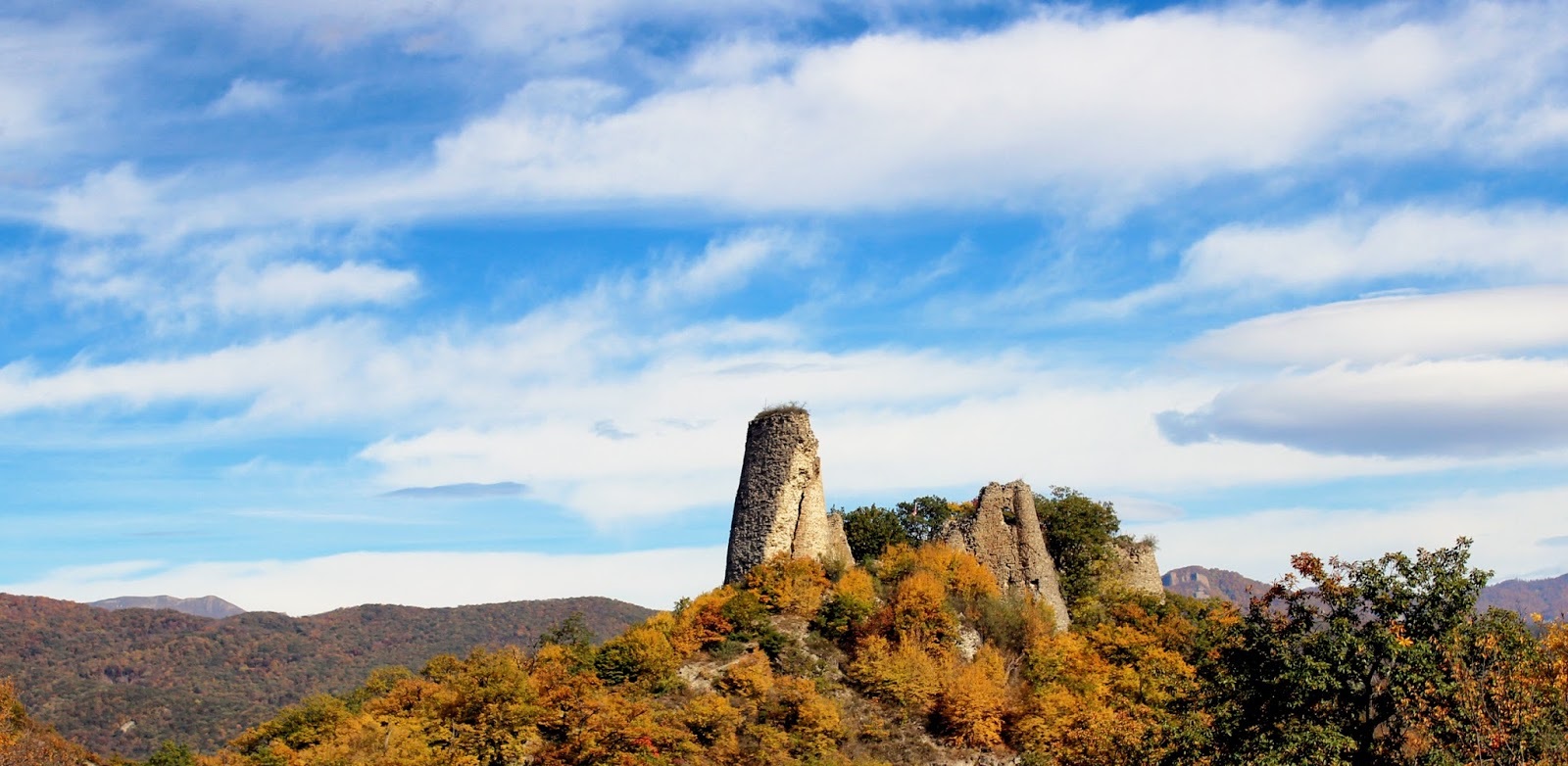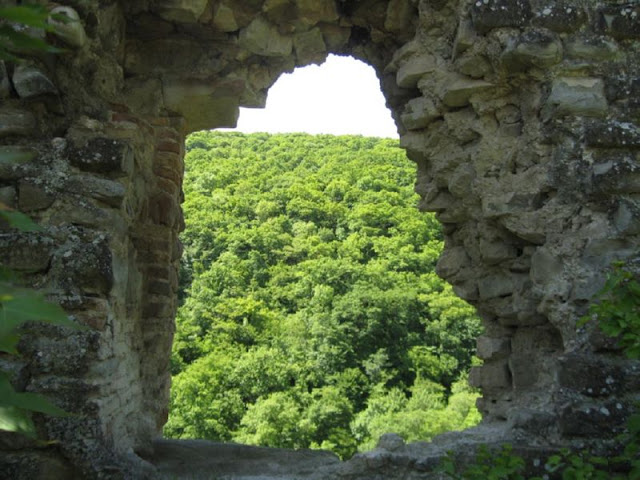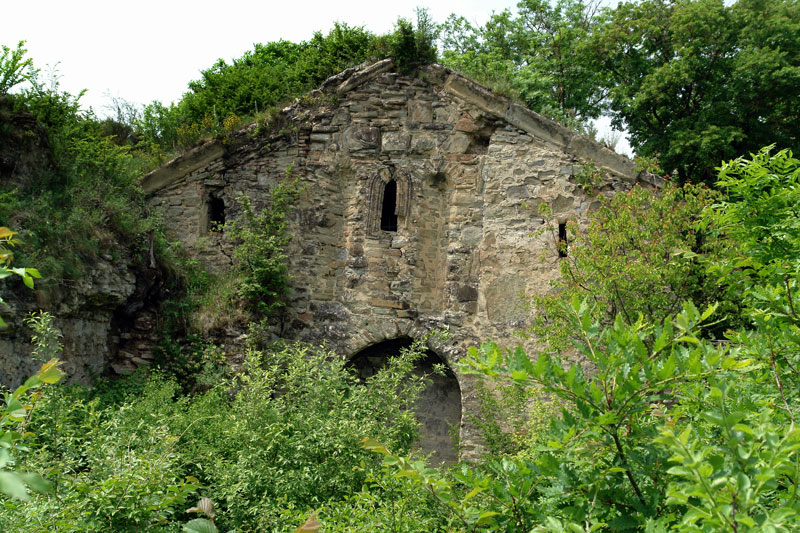ALAVERDI
DETAILS
Alaverdi Monastery is a Georgian Eastern Orthodox monastery located 25 km from Akhmeta, in the Kakheti region of Eastern Georgia. While parts of the monastery date back to 6th century, the present day cathedral was built in the 11th century by Kvirike III of Kakheti, replacing an older church of St. George.
The monastery was founded by the Assyrian monk Joseph Alaverdeli, who came from Antioch and settled in Alaverdi, then a small village and former pagan religious center dedicated to the Moon. At a height of over 55 meters, Alaverdi Cathedral was the tallest religious building in Georgia, until the construction of the Holy Trinity Cathedral of Tbilisi, which was consecrated in 2004. However its overall size is smaller than the cathedral of Svetitskhoveli in Mtskheta. The monastery is the focus of the annual religious celebration Alaverdoba. Situated in the heart of the world’s oldest wine region, the monks also make their own wine, known as Alaverdi Monastery Cellar.
The monastery was founded by the Assyrian monk Joseph Alaverdeli, who came from Antioch and settled in Alaverdi, then a small village and former pagan religious center dedicated to the Moon. At a height of over 55 meters, Alaverdi Cathedral was the tallest religious building in Georgia, until the construction of the Holy Trinity Cathedral of Tbilisi, which was consecrated in 2004. However its overall size is smaller than the cathedral of Svetitskhoveli in Mtskheta. The monastery is the focus of the annual religious celebration Alaverdoba. Situated in the heart of the world’s oldest wine region, the monks also make their own wine, known as Alaverdi Monastery Cellar.
BODBE MONASTERY
DETAILS
The Monastery of St. Nino at Bodbe is a Georgian Orthodox monastic complex and the seat of the Bishops of Bodbe located 2 km from the town of Sighnaghi, Kakheti, Georgia. Originally built in the 9th century, it has been significantly remodeled, especially in the 17th century. The monastery now functions as a nunnery and is one of the major pilgrimage sites in Georgia, due to its association with St. Nino, the 4th-century female evangelist of Georgians, whose relics are shrined there.
DAVID GAREJA
DETAILS
David Gareja is a rock-hewn Georgian Orthodox monastery complex located in the Kakheti region of Eastern Georgia, on the half-desert slopes of Mount Gareja, some 60–70 km southeast of Georgia’s capital Tbilisi. The complex includes hundreds of cells, churches, chapels, refectories and living quarters hollowed out of the rock face.
Part of the complex is located in the Agstafa rayon of Azerbaijan and has become subject to a border dispute between Georgia and Azerbaijan. The area is also home to protected animal species and evidence of some of the oldest human habitations in the region.
Part of the complex is located in the Agstafa rayon of Azerbaijan and has become subject to a border dispute between Georgia and Azerbaijan. The area is also home to protected animal species and evidence of some of the oldest human habitations in the region.
GREMI
DETAILS
Gremi is a 16th-century architectural monument – the royal citadel and the Church of the Archangels – in Kakheti, Georgia. The complex is what has survived from the once flourishing town of Gremi and is located southwest of the present-day village of the same name in the Kvareli district, 175 kilometers east of Tbilisi, capital of Georgia.
Gremi was the capital of the Kingdom of Kakheti in the 16th and 17th centuries. Founded by Levan of Kakheti, it functioned as a lively trading town on the Silk Road and royal residence until being razed to the ground by the armies of Shah Abbas I of Persia in 1615. The town never regained its past prosperity and the kings of Kakheti transferred their capital to Telavi in the mid-17th century. There was big Armenian population. The Russian diplomat Fedor Volkonsky, who was here in the 17th century, said: “Armenians have own church and market behind one was other church”. He also said about 10 Armenian churches near the palace of king
The town appears to have occupied the area of approximately 40 hectares and to have been composed of three principal parts – the Archangels’ Church complex, the royal residence and the commercial neighborhood. Systematic archaeological studies of the area guided by A. Mamulashvili and P. Zak’araia were carried out in 1939-1949 and 1963-1967, respectively. Since 2007, the monuments of Gremi have been proposed for inclusion into the UNESCO World Heritage Sites.
Gremi was the capital of the Kingdom of Kakheti in the 16th and 17th centuries. Founded by Levan of Kakheti, it functioned as a lively trading town on the Silk Road and royal residence until being razed to the ground by the armies of Shah Abbas I of Persia in 1615. The town never regained its past prosperity and the kings of Kakheti transferred their capital to Telavi in the mid-17th century. There was big Armenian population. The Russian diplomat Fedor Volkonsky, who was here in the 17th century, said: “Armenians have own church and market behind one was other church”. He also said about 10 Armenian churches near the palace of king
The town appears to have occupied the area of approximately 40 hectares and to have been composed of three principal parts – the Archangels’ Church complex, the royal residence and the commercial neighborhood. Systematic archaeological studies of the area guided by A. Mamulashvili and P. Zak’araia were carried out in 1939-1949 and 1963-1967, respectively. Since 2007, the monuments of Gremi have been proposed for inclusion into the UNESCO World Heritage Sites.
IKALTO
DETAILS
Ikalto is a village about 10 km west of the town Telavi in the Kakheti region of Eastern Georgia. It is mostly known for its monastery complex and the Ikalto Academy.
The Ikalto monastery was founded by Saint Zenon, one of the 13 Syrian Fathers, in the late 6th century. It was known as one of the most significant cultural-scholastic centres of Georgia. An academy was founded at the monastery during king David the Builder by Arsen Ikaltoeli (Ikaltoeli meaning from Ikalto) in the early 12th century. The Academy of Ikalto trained its students in theology, rhetoric, astronomy, philosophy, geography, geometry chanting but also more practical skills such as pottery making, metal work, viticulture and wine making and pharmacology. According to a legend the famous 12th century Georgian poet Shota Rustaveli studied there.
There are three churches on the monastery grounds – Khvtaeba, Kvelatsminda and Sameba. The main church, Ghvtaeba (Holy Spirit), was built in the 8th–9th century on the site of an older church (in which Saint Zenon had been buried). In 1616 the Persian invaders led by Shah Abbas I set the Ikalto Academy on fire and it ceased to exist.
The Ikalto monastery was founded by Saint Zenon, one of the 13 Syrian Fathers, in the late 6th century. It was known as one of the most significant cultural-scholastic centres of Georgia. An academy was founded at the monastery during king David the Builder by Arsen Ikaltoeli (Ikaltoeli meaning from Ikalto) in the early 12th century. The Academy of Ikalto trained its students in theology, rhetoric, astronomy, philosophy, geography, geometry chanting but also more practical skills such as pottery making, metal work, viticulture and wine making and pharmacology. According to a legend the famous 12th century Georgian poet Shota Rustaveli studied there.
There are three churches on the monastery grounds – Khvtaeba, Kvelatsminda and Sameba. The main church, Ghvtaeba (Holy Spirit), was built in the 8th–9th century on the site of an older church (in which Saint Zenon had been buried). In 1616 the Persian invaders led by Shah Abbas I set the Ikalto Academy on fire and it ceased to exist.
ILIA LAKE
DETAILS
This public, man-made lake is located just a 5-minute drive from the center of Kvareli. With a well-equipped recreation area, you can try cycling, renting a catamaran or paddle boat, swimming in the lake and looking at the forest-covered mountains…
LAGODEKHI PROTECTED AREAS
DETAILS
Lagodekhi Protected Areas, also known as Lagodekhi National Park, is a pair of protected areas in the Kakheti district of Georgia: Lagodekhi Strict Nature Reserve and Lagodekhi Managed Nature Reserve (divided in 2003). The combined area of the two is 24,451 hectares (94.41 sq mi). The reserves are located in north-eastern Georgia on the southern slopes of the Caucasus and border on Azerbaijan and Dagestan. Lagodekhi preserves a variety of rare local flora and fauna and was originally protected in 1912, under the Russian Empire, the first nature preserve in Georgia. Their ecoregion is that of the Caucasus mixed forests.
NEKRESI
DETAILS
Nekresi is a historic town in Kakheti, Georgia, in modern-day Kvareli Municipality, near the village of Shilda. The town was established by king Pharnajom (around 2nd-1st centuries BC). In the 4th century AD, king Thrdat built a church in this place. This church became a refuge to one of the Assyrian fathers, Abibus, in the late 6th century. Around this time Diocese of Nekresi was established, which existed until the 19th century.
The church was recently restored, stone masonry repaired, roof rebuilt, windows put in place.
The church was recently restored, stone masonry repaired, roof rebuilt, windows put in place.
SIGHNAGHI
DETAILS
Signagi or Sighnaghi is a town in Georgia’s easternmost region of Kakheti and the administrative center of the Signagi Municipality. Although it is one of Georgia’s smallest towns, Signagi serves as a popular tourist destination due to its location at the heart of Georgia’s wine-growing regions, as well as its picturesque landscapes, pastel houses and narrow, cobblestone streets. Located on a steep hill, Signagi overlooks the vast Alazani Valley, with the Caucasus Mountains visible at a distance.
Signagi is located in the Kakheti region of Georgia, settled since the Paleolithic period. Signagi as a settlement is first recorded in the early 18th century. In 1762, King Heraclius II of Georgia sponsored the construction of the town and erected a fortress to defend the area from marauding attacks by Dagestan tribesmen.
As of the 1770 census, Signagi was settled by 100 families, chiefly craftsmen and merchants. When Georgia was annexed by Imperial Russia in 1801, Signagi (Signakh) was officially granted town status and became a centre of Signakh uyezd (Russian: Сигнахский уезд) within Tiflis Governorate in 1802. In 1812, Signak joined the rebellion with the rest of Kakheti against the Russian rule. During the Caucasian War, the town “was considered an important point on account of its proximity to” Dagestan.
The town quickly rose in its size and population and became an agricultural center under the Soviet Union. The severe economic crisis in post-Soviet Georgia heavily affected the town, but a major reconstruction project recently launched by the Government of Georgia and co-funded by several international organizations intends to address an increasing tourist interest and modernize infrastructure.
Signagi is located in the Kakheti region of Georgia, settled since the Paleolithic period. Signagi as a settlement is first recorded in the early 18th century. In 1762, King Heraclius II of Georgia sponsored the construction of the town and erected a fortress to defend the area from marauding attacks by Dagestan tribesmen.
As of the 1770 census, Signagi was settled by 100 families, chiefly craftsmen and merchants. When Georgia was annexed by Imperial Russia in 1801, Signagi (Signakh) was officially granted town status and became a centre of Signakh uyezd (Russian: Сигнахский уезд) within Tiflis Governorate in 1802. In 1812, Signak joined the rebellion with the rest of Kakheti against the Russian rule. During the Caucasian War, the town “was considered an important point on account of its proximity to” Dagestan.
The town quickly rose in its size and population and became an agricultural center under the Soviet Union. The severe economic crisis in post-Soviet Georgia heavily affected the town, but a major reconstruction project recently launched by the Government of Georgia and co-funded by several international organizations intends to address an increasing tourist interest and modernize infrastructure.
TSINANDALI MUSEUM
DETAILS
Tsinandali Village, where beautiful summer residence of Georgian aristocratic poet Alexander Chavchavadze is situated. The poet refurbished the estate, constructed a new Italianate palace and built a decorative garden in 1835. It was the place where Chavchavadze frequently hosted and entertained foreign guests with music, wit, and – most especially – the fine vintages made at his estate winery (marani). Familiar with European ways, Chavchavadze built Georgia’s oldest and largest winery where he combined European and centuries-long Georgian wine-making traditions.
UJARMA FORTRESS
DETAILS
City-fortress Ujarma is situated on the right bank of the river Iori, in 45 km to the east of Tbilisi on Gombory Range. Three main periods of construction are defined. In the second half of the 5th century, famous Vakhtang Gorgasal ‘erected numerous buildings in Ujarma’ and moved his residence there. After Vakhtang’s death, his heir Dachi was ruling Kakheti for some period from here. In the 10th century Ujarma was destroyed by Arabian forces of Abul Kassim. In the 13th century, the fortress was restored by King George III, where he arranged treasury.
City-fortress consists of two parts: citadel, located on the plateau of the rocky hill and city on the slope.
City was surrounded by the powerful protective wall with nine quadrangular towers. The towers are three-storied, covered by tiled roof with loop-holes. City gates were in the first tower.
A royal palace – two-storied building with a vault – was located in the eastern part of citadel. Premises were illuminated by big and broad windows and they had hanging balconies.
In the middle part of the citadel was ancient church ‘Jvar-Patiosani’ (Church of the Fair Cross). There were dwelling outhouses opposite the church and big reservoirs to keep water.
The whole main system of protection was established in the epoch of Vakhtang Gorgasal. Ujarma is referred to the best samples of fortification constructions of the ancient Georgia.
In the second period (12th century) the destroyed walls were restored and new fortifications and dwelling places were constructed.
The third period (17th – 18th cc) was represented restoration of destroyed parts of the citadel’s walls.
City-fortress consists of two parts: citadel, located on the plateau of the rocky hill and city on the slope.
City was surrounded by the powerful protective wall with nine quadrangular towers. The towers are three-storied, covered by tiled roof with loop-holes. City gates were in the first tower.
A royal palace – two-storied building with a vault – was located in the eastern part of citadel. Premises were illuminated by big and broad windows and they had hanging balconies.
In the middle part of the citadel was ancient church ‘Jvar-Patiosani’ (Church of the Fair Cross). There were dwelling outhouses opposite the church and big reservoirs to keep water.
The whole main system of protection was established in the epoch of Vakhtang Gorgasal. Ujarma is referred to the best samples of fortification constructions of the ancient Georgia.
In the second period (12th century) the destroyed walls were restored and new fortifications and dwelling places were constructed.
The third period (17th – 18th cc) was represented restoration of destroyed parts of the citadel’s walls.

